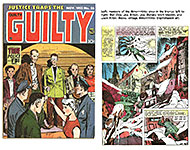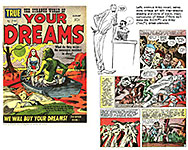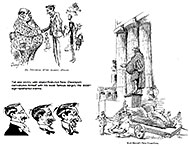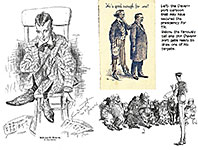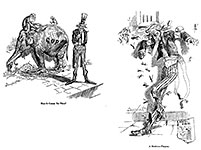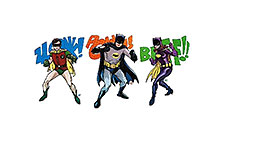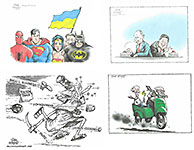 |
||||||||||||||||||||||||||
Opus 367 (June 30, 2017). This time, we review “Wonder Woman” (superb) and “Batman v Superman” (terrible), blast the power of social media to censor (i.e., Bill Maher’s snafu and Megyn Kelly’s diligence), celebrate freedom of speech here and elsewhere, report on the NCS Reubens Weekend in Portland and Jules Feiffer’s new musical, and review Renato Jones (Round Two), Grrl Scouts, the Cartoons of Homer Davenport (alas, seldom discussed in histories of editoonery), Strange World of Your Dreams, and Trumpery in the month’s editoons, plus obits from Adam West and Larry Wright—and more, much more. Here’s what’s here, in order, by department—:
NOUS R US Cartoonists’ Freedom of Expression Threatened Social Media Threatens Free Speech in U.S. Analyzing Bill Maher’s Faux Pas The New Yorker Rumor Mill Notes on Translating Feiffer’s Musical Obama’s Graphic Autobiography B. Kliban Cartoons
MOVIE REVIEWS Batman v Superman: Dawn of Justice—the Worst Wonder Woman—the Best (A Long and Detailed Appreciation)
NCS REUBENS WEEKEND IN PORTLAND Telnaes Wins Cartoonist of the Year Lynda Barry Gets Caniff Lifetime Achievement Award Antics at the Banquet Friday’s Program Saturday’s Program Sunday’s Program
SCROUNGING IN PORTLAND Visits to Book Stores And Treasures Found (illustrated)
FUNNYBOOK FAN FARE Reviews of 1st Issues of—: Renato Jones: Freelancer (Round Two) Grrl Scouts 2nd Issue of Nick Fury THE FROTH ESTATE Trumpery Every Day
NEWSPAPER COMICS PAGE VIGIL What’s Going On in the Funnies
EDITOON EMPLOYED IN NEFARIOUS CAUSE Are Editoons At Fault?
EDITOONERY Analysis and Appreciation of the Month’s Editorial Cartoons The Issues: Trump, Comey, Lies, Paris Accord, Beloved Leader Shoot, Shooting Republicons, Health Care Act, and Etc.
BOOK MARQUEE Short Reviews of—: The Strange World of Your Dreams; Reprint and Comment Forthcoming: To Kill a Mockingbird Graphic Novel
BOOK REVIEWS Longer Review of—: The Annotated Cartoons by Homer C. Davenport
PASSIN’ THROUGH Adam West Larry Wright Rich Buckler
QUOTE OF THE MONTH If Not of A Lifetime “Goddamn it, you’ve got to be kind.”—Kurt Vonnegut
Our Motto: It takes all kinds. Live and let live. Wear glasses if you need ’em. But it’s hard to live by this axiom in the Age of Tea Baggers, so we’ve added another motto:. Seven days without comics makes one weak. (You can’t have too many mottos.)
And our customary reminder: don’t forget to activate the “Bathroom Button” by clicking on the “print friendly version” so you can print off a copy of just this installment for reading later, at your leisure while enthroned. Without further adieu, then, here we go—:
NOUS R US Some of All the News That Gives Us Fits
WORLDWIDE, CARTOONISTS’ FREE SPEECH IS BEING THREATENED It’s been more than two years since the attack on Charlie Hebdo staff in Paris, and although the world’s free expression focus has largely shifted away from cartoonists, “that certainly does not mean the danger has disappeared,” says Maren Williams at Comic Book Legal Defense Fund. “A recent 30-page report from the French nonprofit Cartooning for Peace/Dessins Pour la Paix brings together profiles of cartoonists under threat and background information on the free speech situation in the countries where they work — or from which they’ve been forced to flee.” The report pays tribute to the unique role that satirical cartoonists fulfill in many countries (particularly those in which largely illiterate populations are more than usually susceptible to the messages in pictures), and their defiance in the face of censorship, intimidation, and violence (in italics): Whether their cartoons concern politics, the economy, sports or religion, cartoonists are confronted with the same threats as newspaper, radio and television journalists who cover sensitive subjects. Censorship, legal proceedings, attacks, imprisonment, exile, disappearances and, in the worst of cases, murder— many different acts of violence proving that cartoonists are always on the frontline. Unique witnesses of current events and veritable barometers of the freedom of expression, they defy threats in order to inform us on the state of democracy during periods of insecurity and trouble. In a context where violations against the freedom of expression have worsened, it seems indispensable to give the floor to those who take up the pencil, in order to pay tribute to their backgrounds and struggles. The full report can be found at the CBLDF website (cbldf.org), which also provides an index to CBLDF reports about many of the cartoonists, grouped by country: in Ecuador, Xavier Bonilla (known as Bonil) and Vilma Vargas; in Venezuela, Rayma Suprani; in India, Aseem Trivedi; in Egypt, Islam Gawish. We’ve posted reports about the threats against Zunar in Malaysia, Muksa Kart in Turkey, Ali Ferzat, exiled from his native Syria; and Eaten Fish in Manus Island detention center of Australia. CBLDF’s index rehearses their stories as well as those of the others we’ve just named. By way of showing how detailed the index is, here’s one of several reports about Godfrey Mwampembwa (Gado) in Kenya.
Government Forces Firing of Kenya’s Top Cartoonist (March 2016) By Caitlin McCabe After decades of doing work for Kenya’s largest newspaper, the Daily Nation, the celebrated and most syndicated cartoonist in East and Central Africa Godfrey Mwampembwa (better known as Gado), has been fired due to suspected political pressure from the Kenyan government. Gado, who is regarded by fellow cartoonists to be the “most important cartoonist in Africa,” has illustrated the turbulent political climate of East Africa for 23 years, often focusing on the dwindling state of free speech in countries like Kenya. “I think that freedom of expression of the media in Kenya has been on the right track until recently,” said the cartoonist in an interview with Financial Times. “We’ve seen fight back from this administration. They’ve complained bitterly about lots of things about me–I’ve no problem about that–but what we have seen with the current administration is that they have been trying to roll back the gains that had been achieved in the past.” In 2013 a change in the government led to the implementation of new laws that specifically targeted journalists’ and cartoonists’ abilities to speak freely about the Kenyan government. Under a law passed in October, anyone who was found guilty of “defaming” the Kenyan Parliament could be fined up to $5,000 (USD) and face two years in jail. Gado himself has been under pressure since the change in the government, being forced to take a sabbatical in 2015 after the Tanzanian president, Jakaya Kikwete, expressed his disapproval about one of the cartoonist’s pieces. Gado told the Committee to Protect Journalists: “It is no secret that there were many in government who didn’t like my cartoons over the years. But we had grown used to that and the Nation thankfully consistently pushed back. Things changed in 2013 after a new government came into place and the pressure became far more intense. I have no doubt that the Nation crumbled, which is quite sad and should be seen in the broader context of efforts by those in government to control the press.” Once his year-long sabbatical ended on February 28th, the Daily Nation opted not to renew Gado’s contract. Although the Kenyan government denies that they had a hand in the newspaper’s decision to let Gado go, the concerning state of free press and recent laws implemented in Kenya suggests otherwise. Despite being let go, the cartoonist is dedicated to continuing his work independently and plans to sue the Nation for unlawful termination. In an interview with Sahara Reporters, Gado reminds us and other cartoonists in similar situations that “I have freedom of choice, I will always find a way. Some subjects are tough; you struggle with them but in the end you always find a way to draw and add humor.”
Not that we’re immune from attempts to muzzle free speech in this country. But free expression is so ingrained here that it is sometimes itself the cause of problems—as we see in the next report—:
HERE WE GO AGAIN Comedic Banter Bangs on the Social Media Henhouse Wall Civil rights activists swarmed social media to demand HBO fire Bill Maher after the liberal “Real Time” host said “nigger” during a bantering conversation on June 2 with one of his guests, Nebraska’s U.S. Senator Ben Sasse, a non-conformist Republicon who, among other things, fired off a letter to Attorney General Jeff Sessions, asking how aggressively efforts were being made to convict Julia Assange whose WikiLeaks made him an enemy of the U.S. while the Trumpet and his MAGA legions hail every info dump by WikiLeaks as manna from heaven, according to Vanity Fair’s James Wolcott. “I’ve got to get to Nebraska more,” Maher quipped at one point in their discussion. “You’re welcome,” said Sasse, “—we’d love to have you work in the fields with us.” “Work in the fields?” responded Maher. “Senator, I’m a house nigger.” Realizing from the audible gasp in the audience that he’d transgressed, Maher said immediately: “It’s a joke.” Maher apologized the next day: “Friday nights are always my worst night of sleep because I’m reflecting on the things I should or shouldn’t have said on my live show,” he said. “Last night was a particularly long night as I regret the word I used in the banter of a live moment. The word is offensive, and I regret saying it and am very sorry,” he said. But that wasn’t enough. Activists created a #FireBillMaher hashtag on Twitter. “Bill Maher has got to go,” tweeted Black Lives Matter activist DeRay Mckesson, quoted in The Week. Chiming in, HBO called Maher’s remark “completely inexcusable,” adding: “We are removing his deeply offensive comment from any subsequent airings of the show.” Maher sought to make further amends the next week. Doubtless fearing for his job, he invited a special guest to open the show with him—Dr. Michael Eric Dyson, a college professor who is an African American friend of the show (and of Maher) and author of dozens of books about race. Dyson would take the place of Al Franken, who cancelled his scheduled appearance on the show because of the controversy. Franken was the second most recurring guest on Maher’s “Politically Incorrect” show, and he and Maher are long-time friends. “I kind of understand how he did what he did,” said Franken, who was a stand-up comedian before becoming a U.S. Senator, “— but he should know by now. He’s been around too long, and he can’t do that. He screwed up so let him take care of it. I just felt like, what’s the point of me sitting there and criticizing him for that and giving him my take on what he did? I didn’t want a week of people blasting me for it. And I just want to make it clear: I didn’t think it was acceptable. Dyson makes a lot more sense for the show.” Other scheduled guests stayed on—Republican Rep. David Jolly, rapper Ice Cube, and Bernie Sanders former press secretary, Symone Sanders. Dyson, quote by Jessica Chasmar in the Washington Post, made his loyalties clear in advance of his appearance: “Bill Maher has bravely, and relentlessly, pilloried racism, white privilege, and white indifference to the black plight. Plus, he has, from the start, featured brilliant black personalities on his shows, whether on network tv or now cable. In short he has used his platform to highlight black faces, and amplify black voices that might never have otherwise been given such a prominent perch to tell their truths. Given the Bill Maher I know, he will use this opportunity to strengthen his role as an ally to black people.” Maybe, maybe not.
MAHER BEGAN HIS SHOW the Friday after his faux pas by saying to an applauding audience, “Thank you for letting a sinner in your midst.” After his customary monologue, he joined Dyson, who, Maher said, would “take him to the woodshed” for his inexcusable remark the previous week. Then he began an embarrassing segment of self-flagellation unequaled in national television. Dyson launched into a succession of explanatory paragraphs about “unconscious white privilege,” the racial insensitivity of using the n-word, and so on, and the ways Maher’s joke offended people of color. At one point, he outlined the history of the verbal slur, its roots in chattel slavery and its function as a reiteration of black subservience to whites. Said Maher: “Surely, you must know all that wasn’t going through my mind, right?” He responded to other Dyson comments—all made in the friendliest manner, albeit unyielding in criticism of Maher’s error—with a series of apologies and excuses: “It’s not like I made a career with this.” “I grew up in Jersey in the 50s and 60s. Race wasn’t even an issue. It didn’t exist.” “I don’t wanna pretend this is more of a race thing than a comedian thing.” With that last comment, Maher came close to the heart of the matter, the core that everyone else overlooked all evening long. Ice Cube, quoted by Desire Thompson at vibe.com, was not gentle. “I knew you was going to fuck up sooner or later,” the rapper said. “I love your show, but you been bucking up that line a little bit. You got a lot of black jokes. ... Sometimes you sound like a redneck trucker.” He then called out Maher’s hypocrisy and alleged “pass” he might believe exists because of his ties to the black community as well as his dating life (unmarried Maher has dated several women of color over the years), Thompson said. “I accept your apology,” said Ice Cube, “but I still think we need to get to the root of the psyche because I think there are a lot of guys out there who cross the line because they a little too familiar ... or guys who had a black girlfriend or two that made them some Kool-Aid now and then think they can cross the line, and they can’t.” Maher tried to defend himself, but Ice Cube was having none of it. “That word is like a knife,” he said. “You can use it as a weapon or you can use it as a tool. It’s been used as a weapon by white people, and we’re not gonna let it happen again. That’s our word now, and you can’t have it back.” Symone Sanders pointed out that “house niggers” during slavery times didn’t have as cushy a life as Maher’s remark supposed: they were often beaten and frequently raped. Riveting television though these parts of Maher’s show were, they handily avoided the heart of the matter in favor of whipping up anti-racist sentiment in a great display of righteous indignation. And Maher’s arranging for his own pillorying in public may have been brave, but it yielded several cringe-worthy moments of embarrassing tv. Maher’s mea culpa was, in fact, excessive, and watching it made me squirm. Yes, I know: only a person gifted with unconscious white privilege can take that position. And I’m as guilty as the next white person. We’re all racists whether we know it or not. Our culture is forever stained with the legacy that owning slaves has left us. In contemplating that hideous heritage, we often forget that slavery was not peculiar to the United States—that, in fact, it began in Africa when conquering tribes made slaves of their captives and often sold them to passing Muslims. Why America is so peculiarly cursed with its history of slavery is a puzzle: other nations have apparently moved on and left their history in the past where it belongs. We have not been able to. Probably because significant segments of the white population didn’t want to, instead clinging to their white privilege—and not unconsciously. That, however, is a topic for another discussion on another day. Today, we’re pondering Maher’s predicament. And to do so, let us analyze his remark in the context of the joke he thought he was making. Maher is, after all, a comedian, and he was telling a joke. Let’s see how the joke worked.
IT IS SENATOR SASSE’S use of the expression “working in the fields” that sets up for the joke. That and his social position. As a Senator, Sasse is a member of the ruling class, superior to the rest of us peons. In the context of their conversation, his invitation to Maher to work “in the fields” asserts that superiority over Maher. Maher’s response is a rejoinder that accuses Sasse of an attitude akin to a sense of racial superiority. Maher could have said: “Whoa, massa, I don’t work in no fields. Isa house nigger.” The descent into dialect would have increased the aura of offense, no doubt, but it would more accurately reflect the satire in Maher’s comedic response. Maher’s satirical retort draws attention to Sasse’s sense of superiority—or, to take it a step further, his racist unconscious white privilege. Maher’s remark was not racist. It was, in fact, an anti-racist comeback. Sasse may not have deserved this comeuppance, but given the sense of superiority that infuses much of the GOP’s attitude, Maher was justified in making his satirical attack. And if the numerous discussions that ensued on the June 9 show had taken their cue from Maher’s own reminder that he was a comedian making a wise-ass comment for the sake of a laugh—you know, what comedians are supposed to do?—we’d have had an different sort of show altogether. We might have had a lesson in how satire works. We might have had a genuine examination of aspects of racism in America instead of an accusatory diatribe against a comedian who is so strongly against racism that he subjects himself to a harangue he knows he doesn’t deserve in order to demonstrate his good intentions. Oh—and Ice Cube: African Americans don’t “own” the word nigger. People don’t own words: words are the common coin of the human condition. Remember—asserting ownership of that which cannot be owned is what got us into all this trouble to begin with.
MAHER’S ADVENTURE IS BUT ONE MORE EPISODE in a society increasingly driven by social media—by a cacophony of incendiary verbiage spewed forth by sometimes ignorant albeit well-intentioned persons who don’t know what they’re talking about but they know what they feel. And what they feel often has little to do with a rational apprehension of factual reality. Perhaps the best response to the social media din in this case is to say simply: if you can’t take a joke, then stay away from tv comedies. Just as Maher was trying to extricate himself from the mess he was in, Megyn Kelly was being attacked by social media mavens who objected to her interviewing crackpot conspiracy theorist Alex Jones on her Sunday evening talk show—saying she shouldn’t be giving airtime to such outlandish opinion-mongers (Jones thinks Sandy Hook was a made-up event with actors playhing aggrieved parents; ditto 9/11). Giving Jones a national platform dignifies his absurdities with public attention and lends them credulity. Kelly quite properly said it was a journalist’s job to examine such notions in public— perhaps thereby exposing them as the outrageous fallacies they are. (Jones’ appearance would also enhance Kelly’s ratings in her dual with CBS’ venerable “Sixty Minutes.”) “What we do as journalists is we shine a light on those with power, those with influence, those who have become culturally relevant,” she said, “—and with this influential figure to discuss the considerable falsehoods he has promoted with near impunity. Of course, it’s upsetting to know that doing that causes any upset to the Newtown families, many of whom I know well. But I have to do my job.” Jones, she noted, has found new prominence in the Trump era. He’s gaining in popularity and, perhaps more important, has back-channel communications with the Prez of the United States, who has been known to espouse some Jonesian hogwash. I missed the initial broadcast of this show (being otherwise engaged), but I was happy to note (and hereby quote) Jack Shafer in Politico.com, who said Kelly forced Jones to admit that the Sandy Hook conspiracy theory and others he’s promoted were wrong, called him on his dodges, and left him red-faced, stammering, and sweating. “Short of waterboarding him,” saith Shafer, “I don’t know what more Kelly could have done to expose Jones’ dark methods.” Last night, I tuned up On Demand and witnessed Kelly’s interview with Jones. Shafer is pretty much on target. Yes, Jones was red-faced and sweating, though I wouldn’t say he was stammering. He’s probably always red-faced and sweating. But Kelly was by no means lending him a platform: she was out to skewer him. And did. Just about the time the scheduled Jones appearance on Kelly’s show was being bemoaned, “The Carmichael Show” scheduled for Wednesday, June 14, was postponed because the topic of the show was mass shooting, and earlier that day, the Republican baseball team was attacked by a lunatic gunman. Postponing “Carmichael” was probably a suitable reaction whereas the Kelly brouhaha wasn’t. But the “Carmichael” postponement was a creative and managerial decision, not a response to clamoring social media. And the show has only been re-scheduled, not cancelled forever. Quite apart from the mistaken emphasis in the aftermath of Maher’s comedy, the power of the social media emerges as the genuine cultural evil, the threat to reasoned discourse and the kind of rational decision-making that worked in the Carmichael case. I’m not denying that the word nigger carries a lot of nasty freight. Its use in public discourse may well “shift the cultural norm in a direction that supports both overt expressions of racism and self-esteem protecting denials of unconscious racial bias ... [thereby] giving aid and comfort to the real racists and white supremacists,” as Todd Essig said at forbes.com. The n-word does, indeed, conjure up shameful images of people being treated as chattel not human beings—and of the brutal barbaric abuses that accompanied that attitude. And if using the n-word perpetuates that attitude, then we ought to banish its use forever (even knowing that is impossible). But I also remember when African American comedian Dick Gregory said that he entitled his autobiography “Nigger” so that whenever his mother would hear the word, she’d think people were talking about his book.
THE NEW YORKER RUMOR MILL The story going around in various venues is that The New Yorker’s veteran cartoon editor of 20 years in the job, Bob Mankoff, was nudged off his chair. He and the editor, David Remnick, were both powerful, opinionated personalities, and while Remnick had the final say in selecting cartoons for the magazine, he hadn’t Mankoff’s experience or expertise or insight into cartoon humor, and he often lost in arguments about which cartoons to use. Getting rid of Mankoff was a way of winning the arguments of the future. While it’s impossible for us to affirm the truth of this rumor—which requires more intimate experience of cartooning at The New Yorker than we have here at Rancid Raves—there is suspicious evidence that Mankoff was not ready to retire. He’d scarcely left The New Yorker building before he took a cartoon editing gig at Esquire. Same job, different magazine. This doesn’t sound like a man ready to take up pipe and slippers instead of an editor’s pencil. It sounds, rather, like a man who would have contentedly stayed on the job for the foreseeable future. Offering further evidence of the validity of the contention of our first paragraph is the youth of Mankoff’s replacement: Emma Allen is 29 years old. She’s been on staff at The New Yorker since 2012, merely five years. Some cartoonists submitted cartoons to the magazine for longer than that before being published there. Allen has done some editing and whatnot for an online feature called Daily Shouts—plus a little Talk of the Town and Shouts and Murmurs. She says she’s an avid fan of cartooning and points to a misspent youth cutting out and filing (in a lime-green folder) all the cartoons in The New Yorker. It’s a dubious credential, and it scarcely matches Mankoff’s decades of experience as a cartoonist and cartoon editor. One rumor mongerer says she knows nothing about cartoons and is only twelve years old. That is hardly a statement that can be supported by the available evidence, but it suggests that Emma Allen is likely to be a good deal more malleable to Remnick’s arguments when selecting cartoons to publish in The New Yorker. It sounds very much like what Remnick wants in a cartoon editor is someone to sift through the submissions and winnow them down to about 50 from which he can choose 14-20 for each issue of the magazine. No arguments. But it doesn’t seem likely that Emma Allen will be able to find and nurture new talent for the magazine, which was one of Mankoff’s signal achievements as cartoon editor. I doubt she has the experience to tell newcomers how to tinker with and improve their cartooning enough to qualify for publication in The New Yorker, something Mankoff was always doing (or so he has told us). As for the actual cartoon content of the magazine going forward, we’ll wait and see. My guess, however, is that The New Yorker’s present focus on whimsy and absurdity in cartoons, a notable drift away from its traditional snide social commentary directed at the phoney urban snob of the Big Apple, is evidence not of Emma Allen’s influence but of Remnick’s rejection of Mankoff’s. In other words, we should expect no change in the cartoon content over the next weeks or months. The change has already set in.
NOTES ON TRANSLATING Former Dark Horse editor Diana Schutz spends some of her retirement days translating European comic albums into English for American publication and distribution. Translating from one language to another is much more than simply substituting one word for another. Each language has its own nuances that a good translator must capture. Translating is more like playing from sheet music than it is algebra. Two musicians may play from the same sheet music but the music they make might be noticeably different, each the product of the musician’s individual interpretation of what he sees on paper. Says Schutz: “It’s always interesting to see how [other] translators handle thorny issues [like] culturally specific references, which are tough to get across to the target culture. Have I mentioned some of the struggles I’m having with this Inside Moebius book? The man loved puns and other forms of wordplay: all you can hope to do then, as a translator, is get close or, if you’re lucky, at least give the same flavor. Thankfully my editor at Dark Horse, young Philip Simon, is allowing me to write Translation Notes for the back of the book, because Moebius was so clever in places that any translation winds up being inadequate, so it’s great to be able to explain those bits and at least use annotations to get across just how clever he was.”
FEIFFER HITS THE STAGE WITH A MUSICAL “The Man in the Ceiling” is a new musical based upon Jules Feiffer’s 1995 somewhat autobiographical young adult novel about a boy named Jimmy Jibbett who aspires to be a cartoonist. Feiffer has written plays but this is his first shot at a musical. Premiering May 30 - June 25, the reviews were mixed although the ones I have seen are mostly favorable. In Variety, Frank Rizzo said: “Under the confusing and often clunky direction of Jeffrey Seller (the lead producer of ‘Hamilton’), the result is a shrill, sentimental, repetitive and obvious sketch of a show. Though the script is by Feiffer, the musical lacks the original material’s sly humor, off-beat charm and gentle heart. In the New York Times, Neil Genzlinger: “Like many musicals, ‘The Man in the Ceiling’ was a long time in gestation, and it deserves more development. As of now, this is a show that will teach theatrically inclined youngsters what a relatively sophisticated musical number sounds like. To be truly transporting, it needs more of what makes a Feiffer drawing work: wit, understatement and clarity. Hamptons.com, T.J. Clemente: “The Saturday evening premiere of the musical ‘The Man in the Ceiling’ received thunderous applause and a standing ovation at the Bay Street Theater in Sag Harbor on Saturday June 3. The collaborations of Jules Feiffer (author of the book The Man in the Ceiling) along with music and lyrics by Andrew Lippa (‘Rent’), and director Jeffrey Seller (who produced ‘Hamilton’) bring an innovative and retro dynamic to this bold musical production. The stage design and lighting along with a live orchestra adds a unique panache to this show. Sag Harbor Express, Annette Hinkle: “With a team like that, it's hard to go wrong, and rest assured, this is a polished piece of theater with solid acting, a terrific score and tons of creativity, thanks to an enthusiastic and talented cast and crew..... Ultimately what's missing here is the real gravitas necessary to make the adults in the play become fully realized characters. The lack of complexity in their development leaves the supporting roles nearly as one dimensional as Jimmy Jibbett's cartoons.” Dans Papers, Lee Meyer: “What makes ‘The Man in the Ceiling’ feel so special is that the whole production feels like a love letter to Feiffer. The story may not be entirely autobiographical, but it certainly feels ‘drawn’ from Feiffer's experience as an artist and writer. Feiffer, one of the great living talents of our day, lends his iconic and unique artistic voice to every ounce of ‘The Man in the Ceiling.’” 27East, Lorraine Dusky: “Joie de vivre spills off the stage in the world premiere of ‘The Man in the Ceiling’ currently at Bay Street Theater in Sag Harbor. Based on Jules Feiffer's young adult novel of the same title, this collaboration between writer Feiffer and composer Andrew Lippa bounces along with high-voltage energy to its exuberant end.
Fake News Department OBAMA SENDS PUBLISHER PAGES FOR PRESIDENTIAL GRAPHIC NOVEL According to former President Barack Obama, only the graphic novel format had the expressive palette capable of truly capturing his eight years in office. WASHINGTON—Saying the finished work would become the “definitive take” on his time in the White House, Barack Obama reportedly submitted a collection of pages from his presidential graphic novel, Barack Obama: Renegade, to publisher Image Comics on Thursday, June 8. The
16-page packet of artwork and sample issues, which Obama confirmed he has also
mailed to Fantagraphics Books, Dark Horse Comics, and DC’s Vertigo imprint, is
said to serve as a proof of concept for what he envisions as a sprawling
eight-volume memoir of his presidency. According to Obama, creating an
authentic representation of his two terms in office has required him to use
every tool of the comics medium, from dramatic splash pages in which he appears
silhouetted behind the Resolute desk, to an extended dream sequence set on the
eve of his 2012 reelection, which he said takes “definite cues” from the casual
surrealism of graphic novelist Chris Ware in order to fully realize the
emotional truth of the moment. “I’ve poured everything into Renegade’s panels, and when it’s complete, it will depict these eight years of my life precisely as I experienced them,” said the 44th president of the United States, who told reporters that he planned to pencil, ink, and hand-letter each page of the series himself. [First irrefutable clue that this is “fake news.”] “Readers will get a true sense of my time as president right from the opening of Volume No.1: Preambles & Promises, where I cut between full-color panels of my first inaugural address and stark black-and-white illustrations of ordinary Americans disillusioned by the Great Recession, two protracted wars overseas, and a lack of access to healthcare.” Added Obama, “By the time the editors over at Vertigo read the sequence where I’m climbing the steps of the North Portico, and we suddenly flash back to a parallel scene of my origin story in Honolulu, climbing up a volcanic rock in the exact same pose, I’m pretty sure they’ll be hooked.” The idea for Renegade, which is expected to span more than 1,200 pages when completed, reportedly emerged in the aftermath of the disastrous 2010 midterm elections, when a brooding Obama would stay up late in the darkened Oval Office, drafting hundreds of variations on his concept art to “nail the look” of minor details such as the sunlit sheen on an MQ-1 Predator drone or the exact shade of primary antagonist John Boehner’s blue eyes. Discussing his efforts to capture events on the page just as they happened in real life, the former commander in chief admitted he owed much to Y: The Last Man co-creator Brian K. Vaughan, whose “masterful blend” of rapid-fire action and political intrigue influenced his own approach to the bin Laden raid, which will appear in Volume No.4: Infiltration & Exfiltration. Obama said he created a kinetic sense of motion by extending SEAL Team Six’s HK416 assault rifles into the page’s bleed and lettering the onomatopoeic “chh-chh-chh” of the helicopters in such a way that the words wrap around their whirring blades. “Back in 2013, when I was really torn about how to respond to Bashar al-Assad’s use of chemical weapons, I started imagining myself as two different presidents simultaneously enacting two different policies—and suddenly I knew that was exactly how I had to illustrate this moment of my presidency,” said Obama, whose graphic novel also features dual versions of himself that voice opposing sides of tense debates that play out within his mind. “I started sketching right then and there-: one set of panels in which I launch military strikes, and one in which I don’t. Both end in disaster, showing that, in the end, no good choices were available. “I bet Batman: Year One illustrator [David] Mazzucchelli would be perfect for capturing the mood of a war-weary nation in those scenes,” Obama continued, saying he would be open to collaboration with outside colorists. “God, that would look so freaking cool.” Despite Renegade’s dense political narrative, the former president was quick to note it would also include moments of humor and even tenderness, such as episodes imagined from the perspective of first dogs Bo and Sunny Obama, and recurring romantic vignettes about first lady Michelle Obama, which will be painted in watercolors to provide a stark break from the more rigid inking used to portray his actions as the nation’s chief executive. Obama stressed that, overall, his series would be “gritty, heady stuff,” and more akin to a novel than traditional superhero fare. “Generations from now, I want Americans to be able to read these pages and be confident they’re getting an unalloyed picture of my presidency,” he said. “Renegade will cover mature, difficult subjects, and some of it may require multiple readings to understand, but this graphic novel is the only way to accurately convey my experiences. I realize, of course, it may be a bit too much for more sensitive readers to handle.” Fitnoot. You guessed it: this whole thing is from The Onion, the original “fake news” publication. Nice job on the visuals.—RCH
Fascinating Footnit. Much of the news retailed in the foregoing segment is culled from articles indexed at https://www.facebook.com/comicsresearchbibliography/, and eventually compiled into the Comics Research Bibliography, by Michael Rhode, which covers comic books, comic strips, animation, caricature, cartoons, bandes dessinees and related topics. It also provides links to numerous other sites that delve deeply into cartooning topics. For even more comics news, consult these four other sites: Mark Evanier’s povonline.com, Alan Gardner’s DailyCartoonist.com, Tom Spurgeon’s comicsreporter.com, and Michael Cavna at voices.washingtonpost.com./comic-riffs . For delving into the history of our beloved medium, you can’t go wrong by visiting Allan Holtz’s strippersguide.blogspot.com, where Allan regularly posts rare findings from his forays into the vast reaches of newspaper microfilm files hither and yon.
FURTHER ADO Went to a
library book sale last weekend, and among the treasures I brought home was
B.Kliban’s Two Guys Fooling Around with the Moon and Other Drawings, my
first extensive exposure to the bizarre world of Kliban. The cartoon nearby was
among the treats within. “Doing that” makes you wonder, momentarily, what
“that” was. But then, you realize....... How
I missed Kliban all these years—during which, I often heard others raving about
him—I’ll never admit to. But now I’m a convert: I went out into the digital
ether immediately and bought all his other books (Cat, Never
I know: we don’t normally delve into the realms of celluloid adventuring here at Rancid Raves, but I just saw Gal Godot in “Wonder Woman,” and I can’t help myself. She makes the movie one of the best I’ve seen, but before we go into why, here’s the preamble—:
“DAWN OF JUSTICE,” THE WORST MOVIE I’VE EVER SEEN At 45 years of age, actor Ben Affleck is young enough for a superhero movie but old enough to know better. We can’t say the same of Henry Cavill, who reprises the role of Superman to Affleck’s Batman in “Batman v Superman: Dawn of Justice,” undoubtedly the worst movie I’ve ever seen. Except, perhaps, for “Man of Steel,” in which Cavill, then only 30, was still foolish enough to debut as the red-caped savior of the world. Until last night, I stayed home for “Dawn” because “Steel” had been so bad: it was not much more than a series of increasingly destructive train wrecks of Superman throwing himself at General Zod, and vice versa, with disastrous effect upon the architecture of the city in which they battled. The same sort of thing happens in “Dawn.” I watched it only to see Gal Gadot in her maiden appearance as Wonder Woman, my preparation, you might say, for seeing her in the title role in “Wonder Woman,” which opened the weekend after I witnessed “Dawn.” Gadot did not disappoint: she was the best thing in “Dawn.” Next best, Laurence Fishburne as Perry White at The Daily Planet. Affleck was good as the obsessive Bruce Wayne, driven into crime fighting by witnessing the death of his father and mother: Affleck’s grim visage never eased up the whole movie. Cavill was, by turns, anxious and angry, and adequate but scarcely inspired. And the movie as a whole was terrible. To begin with, it was monotonous. Throughout, it was dark: nothing happens in the light of day. And all the action—and the movie was all action, nothing else—no moments of quiet, no exposition—just our heroes and villains punching each other and throwing bodies around, damaging the landscape in the train-wreck fashion of “Steel.” The thumps and crunches are accomplished amid the shrieking sounds of accompanying “music” of the heavy-handed sort. The noise is constant. And everywhere, sinister-looking faces—those of the men, all needing a shave. Most of the time, we don’t even know who the faces belong too. Alex Luthor for one, but after that, it’s all menace and grimace and no personality whatsoever. The climactic scene, which seems to consume maybe half the movie, is a fight with a Marvel character called Doomsday, a giant monster seemingly impervious to whatever Batman and Superman can throw at it. It keeps exploding into fireballs but not disappearing. During this battle, Wonder Woman inexplicably shows up and begins inflicting some damage on Doomsday. Her appearance results in the only satisfying dialogue in the flick: Superman to Batman: “Is she with you?” Batman to Superman: “I thought she was with you.” To kill Doomsday, Superman runs headlong at him with a kryptonite spear, skewering the monster. (Really? Kryptonite is supposed to make Superman weak, as is amply demonstrated in previous sequences; and yet he can hold a spear made of the stuff long enough to impale Doomsday with it? C’mon.) Then a stray bone from the exploding Doomsday plunges into Superman’s chest and kills him. Right. Superman dies at the end of this movie. They bury him. Although Batman alludes, cryptically, to the funeral procession for an “empty box,” i.e., the coffin. Get out. Superman dead? On the basis of Cavill’s acting in these two Zack Snyder movies—and the execrable sound and unending violence—we are grateful. The dawn of justice indeed.
After enduring all of that superpowered bilgewater, I saw “Wonder Woman.”
THE BEST SUPERHERO MOVIE I’VE SEEN While “Wonder Woman” is, like most superhero flicks, fraught with physical violence, in this movie, it all means something. There is a theme. And a message. The ending of the movie puts all that has gone before into meaningful perspective, and we leave the theater feeling good about li’l ol’ humanity instead of being disheartened at the spectacle of mankind’s propensity for brutality and destruction, the prevailing emotion after watching a couple of hours of superheroes pounding each other and wrecking all the surrounding architecture. It helps that Wonder Woman’s costume is appropriate: more like the armor of a warrior than the cleavage of a pin-up, it keeps the focus on the story rather than on sex appeal. And “Wonder Woman” did gangbusters at the box office. In its debut weekend, “Wonder Woman” rang up $103.3 million at the North American box office, the top opening ever for a woman director (that being Patty Jenkins). “Wonder Woman,” starring Gal Gadot in the titular role, becomes only the 16th superhero title to launch to $100 million or more domestically, not adjusting for inflation. “It is no small feat, reported Pamel McClintock, “considering ‘Wonder Woman’ isn't a sequel. Plus the movie skewed female (52 percent), while most superhero films rely on 60 percent or more of the audience being male. It is also the first featuring a female heroine to work at the box office after the quick death of both Catwoman and Elektra in the mid-2000s.” McClintock goes on to rehearse the box office scores of the top 15 superhero openings, dominated by titles from the modern-day Marvel Cinematic Universe mixed in with several movies from the relatively new DC Extended Universe, alongside Christopher Nolan's acclaimed Dark Knight trilogy, Sony's Spider-Man series and Fox's “Deadpool,” among others. Marvel's “The Avengers” (2012) remains the record-holder for top domestic opening with $207.4 million, followed by the 2015 sequel “Avengers: Age of Ultron” with $191.3 million. Fellow Marvel/Disney threequel “Captain America: Civil War” (2016) opened to $179.1 million in 2016, while “Iron Man 3" (2013) blasted off with $174 million. Warners and DC's “Batman v. Superman: Dawn of Justice” (2016) is No.5 on the list with a domestic debut of $166 million. Nolan's “The Dark Knight Rises” (2012) and “The Dark Knight” (2008) opened to $160.9 million and $158.4 million, respectively, in North America, while Sony's “Spider-Man 3" debuted to $151.1 million in 2007. Early last month, Disney/Marvel's “Guardians of the Galaxy Vol. 2" landed at No. 9 on the list of all-time superhero starts when kicking off the summer season with a domestic debut of $146.5 million. That is followed by Warners/DC's “Suicide Squad” (2016) at No.10 with $133.7 million, Fox's “Deadpool” (2016) with $132.4 million and Marvel's “Iron Man 2" (2010) with $128.1 million. In summer 2013, Superman reboot “Man of Steel,” the first title in the new DC Extended Universe, opened to $116.6 million domestically, although, McClintock points out, both that film and the follow-up “Batman v. Superman” were snubbed by critics. Sony's “Spider-Man” (2002) — which cast the mold for the modern-day superhero blockbuster — holds at No.14 on the list with a domestic launch of $114.8 million, not accounting for inflation. Fox's “X-Men: The Last Stand” (2006) rounds out the top 15 with a domestic start of $102.8 million. That means at No.16, “Wonder Woman” beat out the openings of the first two Thor and Captain America movies, as well as the first Iron Man ($98.6 million).
AND THE REVIEWS were mostly raves. At forbes.com , Mark Hughes reports: “Added to the great box office news for ‘Wonder Woman’— indeed, no doubt driving that financial performance— is a 94% Certified Fresh critical reception and an A-grade from audiences via Cinemascore. The Rotten Tomatoes score means ‘Wonder Woman’ is now tied with The Dark Knight and Iron Man as the best-reviewed superhero films in history, and the A Cinemascore is likewise on par with the highest-graded superhero films except ‘The Avengers,’ which is the only superhero release to score a rare A+ from audiences.” “True to the heroine at its core,” said Ann Hornaday at the Washington Post, “‘Wonder Woman’ arrives just in time to save the day on any number of fronts. After the talky and turgid ‘Batman v. Superman’ and hopelessly muddled ‘Suicide Squad’ a year ago, the DC Comics franchise has received an invigorating shot in the metal-cuffed arm of handsome design and snappy storytelling. An indifferent box office promises to get a lift from a genuinely novel protagonist as enigmatic as she is compelling. “And women — long expected to internalize myths of exaggerated male potency as their own — finally have a symbolic universe that feels, if not entirely corrective, at least imaginatively in keeping with their own hopes, dreams and realities. “‘Wonder Woman’ may not cure all the ills of pop culture’s superhero-saturation syndrome; in fact, in many ways it succumbs to some of its worst excesses. But at least it brings an exhilarating, vicarious kick to the sagging, bagging table.” At USA Today, Kelly Lawler said “‘Wonder Woman’ is a departure from most superhero films you’ve seen. It's a female superhero film — which is revolutionary enough by itself — but it's also a genuinely surprising film that plays with genre and throws out the now very tired superhero movie formula. It’s an action film, a romantic comedy and a coming-of-age story and a period piece and a war movie all in one. Above all, it’s a hopeful story about humanity. ‘Wonder Woman’ is the best movie Marvel rival DC Comics has put out in its own cinematic universe, and unlike the recent parade of bleak superhero tales from both studios, it makes you feel good while you watch it.”
AS THE FIRST SUPER MOVIE to star a female and be directed by a female, “Wonder Woman” attracted no little commentary. Said Michael Phillips at the Chicago Tribune: “The director of ‘Wonder Woman’ had to wait 14 years between big-screen projects; her last film was ‘Monster,’ for which Charlize Theron won an Oscar, back in 2003. That says it all when it comes to the odds against women in the film industry. Her movie is no reinvention of a formula; it's simply a much better than usual iteration. And yes, it's about time a woman directed one of these movies, just as it's about time one of these movies was actually about a women. For the first time in a long time, I came out of a DC comic book movie feeling ready for a sequel. It feels right, at this actual historical moment, when men made of something less than steel are bumbling around trying to run things.” Michael Cavna at the Washington Post’s Comic Riffs wrote about how “Wonder Woman” director Patty Jenkins “cracked the superhero-movie glass ceiling. ... For all the wide, high-octane spectacle in the new ‘Wonder Woman,’ perhaps the film’s most special effect involves one central trick: turning the tables on viewer expectations. “Director Patty Jenkins and screenwriter Allan Heinberg take this opportunity to comment on the politics of Hollywood, both on and off the screen — a feat that feels entirely organic to the spirit of their empowered superhero. To accomplish this, the movie deftly uses Diana Prince/Wonder Woman’s superhuman powers and her fish-out-of-water naivete. “On the screen, the filmmakers knowingly flip the script on decades of film’s storytelling tropes, often with a clever wink. “Early in the movie, for instance, right when our male lead might traditionally see his female counterpart in a state of winking undress by the water (think ‘Purple Rain,’ perhaps, or ‘Splash’), it is pilot Steve Trevor (Chris Pine) who is now cast as the ‘bathing beauty’ being played for beefcake. What gives the moment an extra comedic twist is Wonder Woman’s complete lack of embarrassment over catching him in the buff, given her lack of male socialization on all-female Themyscira isle.” Anthony Lane at The New Yorker describes the moment: “Diana enters a grotto and comes upon Steve (what a superbly unmythical name that is) as he getting out of his bath. She stares serenely at his naked male form, the first that she has ever observed, and inquires, ‘What is that?’ “After a mumble of confusion, he says that it’s a watch, and that it tells the time. ‘You let that little thing tell you what to do?’ she asks. Yes, my lady, that’s pretty much it. Rarely has a double entendre done such sterling work.” There are other moments of gentle humor—humane humor—throughout the movie, but, as Cavna observes, “For Jenkins, fortunately, there was no wavering. She was determined to bring to the big screen the fierce-but-compassionate type of Wonder Woman she first saw on the small screen in the late 1970s. “All these years, there’s been talk about Wonder Woman, and the thing I was very firm and steadfast about was: I only wanted to be involved in this if I can have a chance to bring back the Wonder Woman that I love,” Jenkins told Cavna. “I’m not interested in an alt-Wonder Woman; I’m not interested a new Wonder Woman. I’m interested in the Wonder Woman that I grew up with.” “What Jenkins saw in tv’s bicentennial Wonder Woman was something close to the initial ideal of creator William Moulton Marston,” said Cavna. “It’s been interesting that she was created as such an idealized woman who is incredibly powerful who yet has everything about being a woman at her side,” Jenkins continues. “And it’s been funny: Lynda [Carter] was so that in the 1970s with her Wonder Woman.” (Carter’s incarnation of Wonder Woman began December 18, 1976 and ended September 11, 1979.) Interviewed by Emily Heil at the Washington Post, Carter extolled Jenkins’ Wonder Woman:
ONLY A COUPLE OF SOUR NOTES marred the opening of “Wonder Woman.” Cara Buckley reports that Lebanon banned the movie on the eve of its May 31 debut in 15 theaters because its star is an Israeli who, like most Israeli citizens, served a mandatory two-year stint in the Israeli Defense Forces as a combat trainer. Jordan may also have banned the film for the same reasons. And in some venues, theaters offered “women-only” screenings. Sean Carlson at wnyc.org reported that “employees at the Alamo Drafthouse Cinema in Austin and New York capitalized on the excitement, offering women-only screenings and pledging to donate the proceeds to Planned Parenthood. “But J. Stephen Clark, a professor of law at the Albany Law School, took issue with the single-gender screenings. He told Carlson that this kind of discrimination can set a dangerous precedent for other businesses to be selective with the services they provide. “‘That's exactly what pharmacists say, for example, when they want to refuse to fill a woman's prescription for an emergency contraceptive,’ said Clark. He filed the complaint against the Alamo Drafthouse with Austin's Equal Employment and Fair Housing Office. Dunno what became of that. But Lynda Carter scoffed: “I think the women-only screenings are fabulous! That anyone would whine about it — they are extra screenings; they are not excluding anyone. It’s a statement, but I think we need to start spreading the news about a feminism that doesn’t marginalize the men in our lives. We can do something different. And the movie shows that. We have to start spreading that news — that real men change poopy diapers and coach the soccer team and let their daughters paint toenails all kinds of colors.”
THE STORY IN “WONDER WOMAN” isn’t complicated. Ann Hornaday relates its beginning: “The movie plunges into flashback, when the young Amazon princess Diana is living on an idyllic island (no men; none at all) called Themyscira with her mother, Queen Hippolyta (Connie Nielsen) and secretly training with the fierce Amazon general Antiope (Robin Wright). When a handsome World War I pilot crash-lands offshore, Diana — played as an adult by Gal Gadot — rescues him, which leads to a battle with pursuing German forces who are ultimately felled by the Amazons’ acrobatic swordplay, superb equestrian skills, uncanny aim with flaming arrows and all-around badassery.” Alan Zilberman takes up the story (and I embellish his telling). The pilot whom Diana rescues, Steve Trevor, is an American spy who, instead of being delighted at finding himself the only man on an island with hundreds of beautiful women, is eager to return to World War I. He explains the conflict, noting how the latest chemical weapon could lead to the death of millions. To Diana, this all sounds like a prophecy about Ares—the God of War—who aims to decimate humanity out of spite against Zeus. She decides to follow Steve, abandoning all that she knows, in order to end the fighting (and war in general) once and for all. Says Zilberman: “Diana’s isolation is the key to the character’s central appeal. She is devoid of cynicism or doubt, so her moral compass is sharply defined, and she always speaks frankly. This trait can lead to genuine heroism: there is a bravura sequence where Diana is moved by death along the trenches, and jumps into No Man’s Land to stop the enemy. ... She marches implacably forward, full of courage and determination, and the weapons of modern warfare are helpless against her flashing bracelets. Diana’s steely gaze and costume contrast the hopeless greys of the battlefield, deepening the sense of her power.” She encounters and defeats on the battlefield a giant soldier she thinks is Ares, thereby completing in her own mind her mission, and with that, the movie closes. Graeme McMillan finishes the tale: “In the film, Steve Trevor sacrifices himself, telling Diana that while he can save the day, she ‘can save the world’— which is why he must be the one to fly off with deadly gas and destroy it, killing himself in the process. There does not appear to be any reunion (ala Steve Rogers and Peggy Carter in “Captain America: Winter Soldier”). Steve really is gone.” “Her nature also leads to lighter moments,” Zilberman continues, “—such as her joy over seeing a baby, or trying ice cream. This is all familiar ‘fish out of water’ territory, but Godot elevates it with reserves of natural charisma. She’s also improbably beautiful, leading to a running gag where her looks baffle men and women alike.” Overall, Zilberman finishes, “the movie [is] a muscular, playful, satisfying example of the genre at its finest. If anything, it will leave us mildly annoyed that it took so long to make a movie about her in the first place.” “None of this would work at all without the proper actress at “Wonder Woman’s” core,” says Hornaday, “— and Gadot acquits herself with distinction, expressing power not merely as a display of cool moves and physical derring-do, but quiet focus and almost nonchalant self-possession. Cool, solemn, her eyes often welling with tears at the human waste and destruction she witnesses, Gadot’s Diana is the very opposite of a cartoon character: she’s soulful and utterly credible, even when she comes out bracelets blazing, effortlessly scaling a tower that might have imprisoned a princess like her in another story, at least until the right hero came along. As a young woman just coming into her superhuman powers, Gadot finds the right balance between doelike naivete and determination.” And toughness. Beautiful as Gadot undeniably is, her face has about it the aspect of firm resolve and dedication. Not unlike that of the actress herself. Sara Pullman Bailey at washingtonpost.com tells us that Gadot, whose grandfather survived Auschwitz, was born and raised in Rosh Haayin in Israel and was a motor-bike riding Miss Israel at age 18. “In an interview with ABC, Gadot joked that being pregnant as Wonder Woman (she did some shoots in the “Batman v Superman” movie when she was five months pregnant) was harder than being in the Israeli army.” She hid the news from her co-stars, said Allison Glock in Marie Claire, “occasionally racing off to vomit where no one could see her.” “I gutted it out,” Gadot told Glock. “I started to come to set with sunglasses. I had this jug of water with huge pieces of ginger. They thought I’d gone Hollywood.” In reality, Glock went on, “Gadot intensely dislikes Tinseltown’s superficiality. ‘In Israel, people have chutzpah,’ she says, raising her fist.”
THEMES AND FLOURISHES. At first, the movie gives us a Diana understandably naive about the world of men and warfare that she encounters, and a certain silliness lurks in these scenes. But once we get into World War I, that pretty well vanishes. The First World War is a useful locale for Wonder Woman’s debut in film. Warfare was not yet technological, so battles could be fought and won by people not machines. That setting provides a good excuse for all sorts of physical action but not the meaningless fisticuffs and exploding buildings of, say, “Man of Steel” or “Batman vs Superman: Dawn of Justice.” “Wonder Woman” is also a romance. Diana and Steve are clearly fond of each other (and more than that, I ween). Thankfully, we do not have to endure sweaty moments of naked ecstasy between them. They probably slept together one convenient night, but it’s only suggested, and not too obviously (except for consenting adults)—almost in the vein of old timey movies before lovers were permitted to strip feverishly in the heat of passion to demonstrate their love on screen. This deviation from modernism is one of the film’s most refreshing aspects. In the film’s closing moments on the battlefield, “Ares” convinces Diana that humankind is petty and vicious. She agrees, but says they are more than that. “It’s not about what you deserve,” she says, “—it’s about what you believe. And I believe in love.” And so she vows to go on fighting for the sake of love. This moment of epiphany occurs as she holds a tank aloft over the head of the evil chemical scientist who manufactured mustard gas. As she stands there, the screen fills with a reprise of a moment between her and Steve. When we first witnessed this sequence, we could not hear what Steve was saying; and now, we can. And his last words before he leaves on his fatal last mission are “I love you.” Then Diana drops the tank. Gadot’s Wonder Woman will return in “Justice League” in November. She rescued “Batman v Superman” and maybe she’ll do the same with JLA. Alas, cynic that I am, I doubt it. But whatever the outcome in the future, her and Jenkins’ Wonder Woman have raised the bar for superhero movies hereafter.
CARTOONISTS LAND IN PORTLANDIA The National Cartoonists Society’s Reubens Weekend THIS YEAR’S REUBENS AWARDS weekend in Portland, Oregon, May 26-28, was attended by over 250 people, which included about 140 members of the Society plus their wives children and other hangers-on. The Reubens Banquet is always a historic event, but this year it was more than most, PRNewswire observed: Ann Telnaes became first female cartoonist to win both the Pulitzer Prize for Editorial Cartoons (2001) and Reuben Award for Outstanding Cartoonist of the Year. An elite group of nine male cartoonists precedes Telnaes as winners of both the Pulitzer Award and the Reuben Award. In order of their Reuben Award wins, they include Herbert Block (1956), Bill Mauldin (1961), Pat Oliphant (1968 and 1972), Jeff MacNelly (1978 and 1979), Mike Peters (1991), Jim Borgman (1993), Garry Trudeau (1995), Mike Luckovich (2005) and Michael Ramirez (2015). She is, then, the tenth editorial cartoonist to win the Reuben, not the ninth as we reported a few weeks ago in a special Bunny Bonus bulletin about the Reubens. In accepting the Reuben Award, Telnaes offered praise and encouragement for the work of all cartoonists, PRNewswire reported. In regards to editorial cartoonists, Telnaes, the current president of the Association of American Editorial Cartoonists, mentioned how proud she was of her colleagues because "while the news media did not hold Donald Trump accountable during the election, editorial cartoonists did." Speaking about all cartoonists, Telnaes observed, "A lot of you don't consider yourselves to be editorial cartoonists but there are a lot of you doing some really good social commentary. So keep it up because we need it." We
posted our timely, broken but still, oddly, fresh news report of the award
winners as a Bunny Bonus several weeks ago, so I won’t rehearse any of that
here. I must add, however, the winner of the Milton Caniff Lifetime Achievement
Award—Lynda Barry. Barry belongs to the “altie” adjunct of underground cartooning. Her work appeared for years in alternate weekly newspapers, notably Ernie Pook’s Comeek, an eccentric slice-of-life-ish strip that ran for two decades. She has worked as a painter, writer, illustrator, playwright, editor, commentator, cartoonist, and, these days, teacher. She garnered attention with her 1988 illustrated novel The Good Times Are Killing Me, about an interracial friendship between two young girls, which was made into a play. Her second illustrated novel, Cruddy, first appeared in 1999. Three years later she published One! Hundred! Demons!, a graphic novel she terms "autobiofictionalography.” What It Is (2008) is a graphic novel that is part memoir, part collage and part workbook, in which Barry instructs her readers in methods to open up their own creativity; it won the comics industry's 2009 Eisner Award for Best Reality-Based Work. In Lynda Barry: Girlhood through the Looking Glass, Susan E. Kirtley conducts an analytical 300-page survey of Barry’s works In recognition of her contributions to the comic art form, Comics Alliance listed Barry as one of twelve women cartoonists deserving of lifetime achievement recognition, and she received the Wisconsin Visual Art Lifetime Achievement Award in 2013. In July 2016, she was inducted into the Eisner Hall of Fame. She is currently an Assistant Professor of Interdisciplinary Creativity at the University of Wisconsin-Madison. Barry made a presentation about creativity on Saturday afternoon and demonstrated, once again, her mastery of the platform and her incomparable wit as well as keen insight into the workings of the creative mind.
THE REUBENS BANQUET itself was wearingly looooooooooong: it started with the cocktail hour at 6 p.m. and didn’t finish until midnight. Five hours of sitting there and, intermittently, applauding. The length is preordained by the evening’s program—the presentation of almost two dozen awards of various kinds. To that agenda this year, NCS Prez Bill Morrison added another thirty minutes to list all the people connected to the festivities in order to thank them. The list was so long that his wife Kayre took over half-way through. Among those thanked, of course, were the syndicates and publishers who paid for the cocktail hours and meals. (With all that sponsorship, I had to wonder what my $370 registration fee was paying for.) And then the master of ceremonies, Nick Galifianakis, extended the length even more with his self-indulgent display of dubious add-lib wit. Galifianakis has a clever pen which he routinely deployed illustrating his ex-wife’s advice column, Tell Me About It, in the Washington Post. And he’s illustrated books and, unless my memory betrays me, he had a couple of “cartoons” published in the new cartoon-less Playboy. And, as noted in our Bunny Bonus, he won the Rube for Newspaper Panel Cartoon, his second Rube: he won in 2012 for Advertising Illustration. I’ve usually enjoyed his work (except the exceptionally simple childish renditions in Playboy), but his emceeing was another matter. Since I don’t hear well enough to judge his comedy, I rely upon the reactions of those around me, who said he was funny once he got warmed up. And that was okay. But the Banquet breaks into two parts just after presenting the Caniff Award, and Galifianakis decided to do something “a little different” to launch into the second part: after the 15-minute break, he started returning to the podium from the back of the banquet room, walking through the tables, pausing to make funny remarks about the people he saw en route. That added at least another 30 minutes to an already interminable evening. Amusing it may have been, but it seemed to me entirely self-indulgent: Galifianakis determined to display his ability to ad-lib wittily at all cost. His wit, however, deserted him when he accepted the Rube for Newspaper Panel Cartoon: he said only, “I’m embarrassed.” Why?
THROUGH THE DAY ON FRIDAY AND SATURDAY, we were entertained by various cartoonists on various topics. On Friday, we began with a presentation about using Wacom by Jason Chatfield, an Australian now living in the U.S. but producing Australia’s iconic comic strip, Ginger Megs. Next came two cartoonists from Britain, Graham Dury and Simon Thorp, who discussed their humor magazine, Viz, its comic strips and faux advertising. Then Brian Walker, writer for his father’s Beetle Bailey and for Hi and Lois (which his father invented but doesn’t draw), showed vintage movies and rare artwork to illuminate the “legends of the Reubens”—like the time that Hugh Hefner hosted the cocktail party at the Playboy Mansion in 1983, or when Bud Grace was severely scolded for drawing a moustache on an oil portrait during the 1991 cruise to the Bahamas. The afternoon concluded with Brian Basset’s presentation, “everything I learned about cartooning I didn’t learn in kindergarten,” during which he traced his growth and development from editorial cartoonist to strip cartoonist, first on Adam (now called Adam@Home), which he gave up several years ago to do another strip, Red and Rover, about a boy and his dog. That evening, the traditional welcoming cocktail party took place at Wacom headquarters, buffet dinner and drinks in a rooftop diningroom with a good view of the city. Saturday’s program began with Dark Horse’s Mike Richardson, who traced his history as it is connected to his founding and subsequent management of his publishing operation. “He began as a freelance artist, opened a retail comic book and pop culture shop (which lead to a chain of stores), founded Dark Horse comics with the revolutionary idea of running a comic book company with a focus on creator rights, and established Dark Horse Entertainment as a way of getting comic book properties onto screens big and small.” It all started for Richardson when he realized that comic book cartoonists signed away their rights—their ownership—to everything they created. “Being that my own background was in art, I was upset by that,” he said in an interview in that week’s Willamette Weekly. “So when I got the idea of starting a publishing company, I thought it would be a good business practice and the moral thing to do to let people who created characters and projects actually own them and have a say in what happened to them.” He reviewed his own evolving engagement with comics—from DC to Archie to Marvel, “obviously Mad magazine,” to undergrounds. “So it’s been a constant evolution, and it’s all led up to my philosophy of what Dark Horse is. It’s always been my opinion, which has turned out to be true, that if we can distribute a broad range of material over different distribution channels that we an reach a broader range of readers.” And that’s how he’s run Dark Horse, producing different products for different audiences, and reaching them through distribution systems with different target audiences. Next on the program was “The Simpsons.” With 28 seasons and 600 episodes, “The Simpsons” may not be the funniest half-hour on tv, but it’s the longest-running animated series in television, and its creators showed up as a panel— Matt Groening, David Silverman, and Tom Gammill— to comment on their achievement and to show clips from the show. And then Lynda Barry shared stories of her career, with an emphasis on how she nurtures creativity in her students.
Sunday, as usual, was comparatively empty of programming, but what programming there was may change the Reubens Weekend in future. The afternoon was devoted to a “signing”: those with books to sell brought the books to tables in a hotel ballroom, and, in a precedent-shattering maneuver, the general public was invited in to buy books and get them autographed by their favorite cartooners. NCS has been rigidly protective of its privacy in recent years: the entire weekend has been off-limits to fans. Apparently years ago, fans showed up throughout the festivities, shaking hands and asking for autographs, thereby preventing cartoonists from enjoying the events and themselves. So NCS went private with a vengeance. And in the process, abandoned the logic of the central event. The Reubens Banquet, a black-tie affair, was initially conceived as a showcase of cartoonists. That’s why the black-tie formality: dressed up, cartoonists would show that they aren’t unshaven louts in shorts and t-shirts, crouching at their drawingboards in the attic. They clean up fine. The impulse to privacy destroyed the reason for dressing up, but we continue to dress up anyway, having forgotten the reason for it. This year’s signing event will doubtless change all that. It was a remarkably successful event with lots of civilians thronging the room and buying books and sketches. I expect it’ll be repeated next year. I sold several copies of my newest tome, Insider Histories of Cartooning, and of my Not Just Another Pretty Face: The Confessions and Confections of a Girlie Cartoonist. But the big event for me was when a bearded Gus Frederick wandered by and was about to buy a book when I noticed he had a book about Homer Davenport under his arm. Davenport is one of the giants of editorial cartooning in the first decade of the 20th century, but virtually nothing has been written about him. Frederick’s book reprints a 1898 book of Davenport cartoons with annotations that explain their significances; I’ve reviewed the book at greater length down the Scroll. Seizing upon this find, I quickly traded Frederick a copy of my Insider for a copy of his Davenport. And a good time was had by all. The weekend concluded Sunday evening with a Farewell Buffet and Movie Night with Bill Plympton, who showed and commented upon a selection of his animated cartoons. And that was it for another year.
SCROUNGING IN PORTLAND And the Vintage Cartoons Magazine The thing about Portland is Powell’s bookstore. “Powell’s City of Books” may not be the largest bookstore in the country, but with four floors in a building covering an entire city block, it must be the next best thing. Founded in 1971, Powell’s houses over a million used and new titles, so when I saw that the NCS program had a couple gaping holes in it, I knew I’d have time to visit Powell’s when I was in town. And I did. Bought a couple books, too. Among them, a bound volume of Cartoons Magazine from 1917, six months’ worth of the periodical, which I obtained for a mere pittance—$14.95. Initially called just Cartoons, the magazine was launched in Chicago in January 1912 by H.H. Windsor, who was committed to the notion of the cartoon as a serious journalistic form. A typical monthly issue, which sometimes reached 150 pages, reprinted selections of editorial cartoons from newspapers hither and yon and accompanied them with interpretive articles, often grouped under headings, “The Railroads’ Toll of Death,” “The New Styles,” and, since the U.S. was engaged in 1917 in World War I in Europe, “Why We Are Fighting,” and the like, with a parade of Kaiser cartoons. Eugene Zimmerman, the great Zim, had a regular column of social commentary, “Homespun Phoolosophy,” which he accompanied with drawings, and another department, “What the Cartoonists Are Doing,” featured news of the comings and goings of the inky-fingered corps. Billy DeBeck, who was then producing editorial cartoons until he hit upon Barney Google in 1919, did page about tricks of the trade, treated comically, and other cartoonists jumped in from time to time with similar glimpses behind the scenes. Hereabouts, I’ve posted samples. And from time to time, we’ll return to mine some more of the vein of insights Cartoons Magazine offers.
Portland stuck me as a small town stuck in a big city. Few of its downtown buildings are tall, f’instance. I walked up and down SW Sixth Street a couple times going to and from Powell’s, and I was entertained all the way with “public art”—statues and sculpture, sometimes of a whimsical sort.
The big paper in town is the Oregonian, but I picked up a copy of the Portland Tribune. The Oregonian gets all the top comic strips, so the Tribune has the second tier favorites, which, as you can see near here, includes some charmers— Scary Gary by Mark Buford and Dog Eat Doug by Brian Anderson, not to mention John Deering’s Strange Brew, Jerry Van Amerongen’s Ballard Street, and Mick and Mason Mastroianni’s Dogs of C Kennel; I’ve posted a couple of each at the corner of your eye. The strips appeared as they are here, two in a single issue of the paper, which suggests that maybe the Tribune doesn’t publish every day.
T-SHIRT SLOGANS TO LIVE BY It’s not really hoarding if you have cool stuff. To my children: never make fun of having to help me with the computer stuff—I taught you how to use a spoon. Everyone should believe in something. I believe I should be on a beach drinking margaritas. I already want to take a nap tomorrow. Word of the Day: Exhaustipated. When you’re just too tired to give a shit.
FUNNYBOOK FAN FARE Four-color Frolics An admirable first issue must, above all else, contain such matter as will compel a reader to buy the second issue. At the same time, while provoking curiosity through mysteriousness, a good first issue must avoid being so mysterious as to be cryptic or incomprehensible. And, thirdly, it should introduce the title’s principals, preferably in a way that makes us care about them. Fourth, a first issue should include a complete “episode”—that is, something should happen, a crisis of some kind, which is resolved by the end of the issue, without, at the same time, detracting from the cliffhanger aspect of the effort that will compel us to buy the next issue. A completed episode displays decisive action or attitude, telling us that the book’s creators can manage their medium.
THE SECOND ROUND of Renato Jones: Freelancer, created, written, drawn and OWNED (right: in caps) by Kaare Kyle Andrews, is the story of love derailed, and it’s told in Andrews’ frenetic, episodic manner. Don’t look for narrative coherence here: watch recurring characters in rapidly changing locales, pacing the tale in starts and feints. The opening sequence reprises the final scenes of the first series, ending with Renato Jones as Freelancer swearing to destroy Douglas Bladley by taking all his money. Then, in a flashback, we see Renato as a child meeting Bliss, also as a child; and she swears she’s his “for life.” When we next see her, she’s been dating Bladley, and she complains about his being missing; ditto his money. Bliss is the daughter of Nicola Chambers, a political rich con man, conning the disenfranchised. “Let’s make America hate again,” he says, echoing you-know-who. Next, we’re in an airplane, piloted (it seems) by Freelancer. All color drains from the pages as the plane invades protected air space and is shot down. Freelancer, however, survives and lands entact. He goes after a armored character with “WA” on his chest. Perhaps Chambers’ retinue? The airplane crash, it develops—by inference, none of the narrative is straightforward chronology—is seen as a terrorist attack, and Chambers is spirited away by his bodyguards, despite his demanding that they find his daughter and take her with them. She, however, is somehow in the clutches of WA. Freelancer rescues her, and they run off together, still depicted in stark enigmatic black-and-white, forms and features only partially depicted, the shadowy parts, the rest, vanishing into a sea of white space. When WA catches up, Renator—minus his Freelancer mask— dispatches him with Freelancer’s slogan, “Choke on this”—usually accompanied by his flashing a monstrous heavy-duty hand-held weapon. Renato takes Bliss “home.” There, she pleads—no more masks, no more lying. She strips herself naked and approaches Rentao. “I’ve been waiting for you,” she says, stroking his face—and color comes in again to the pages. Two solid black pages intervene before she can kiss him. Renato muses, “It’s always been you.” And then—perhaps they make love. Probably not (as you’ll see). Renato’s musing continues, white lettering on a black ground: “We don’t just fall into one another—we explode. Nothing matters. Nothing but you.” Then a flashback to his youth as a student, studying his fate. Tutored by an old bearded man, Renato sees Bliss’ name on a list of miscreant rich guys. And then we’re back. They haven’t been making love. Renato stops Bliss before they kiss. “I can’t,” he says and leaves, back to his masked life as Freelancer. And Nicola Chambers, having survived the deadly terror attack, is sworn in as President of the United States, Bliss at his side. What will become of Chambers, who is surely one of those the Freelancer has been bred to dispose of. And Bliss? And the supposed love between her and Renato? That’ll being us back. But the delight in reading this book—as in the first series of Andrews’ creation—is in encountering and sorting your way through the visual episodic manner of his storytelling. There are no completed episodes in Andrews: every episode is interrupted by another episode. Crammed with close-ups and soaked in black, the pictures barely tell the story. Only in retrospect, looking back over the trail of pictorial episodes, can we discern a storyline. Narrative breakdown and panel composition carry the story even as they interrupt it. And Andrews deploys color and pagination for added effect. If you want to know what comics can be, here’s a place to get a few clues.
JIM MAHFOOD IS BACK, writing and drawing Grrl Scouts No.1, “Magic Socks,” in which he competes with Andrews for visual daring and panache with the kinky-est cartoony graphic styling in comics. His lines are brittle, his forms angular, and page layout squirms uncomfortably throughout. In the opening sequence, Jose is discharged from psychiatric ward into the hands of her mother but they encounter “delinquents” hovering by their car. They’re Jose’s friends, and at her bidding, they kill the mother, and they all go off in the car, hunting her cousin Daphne Sanchez, one of the trio of Grrl Scouts. Daphne and her pals Gwen and Rita, the Grrl Scouts, are “bad-ass bitches who live in Freak City and who deal weed disguised in cookie boxes” (hence, we assume, their guise as Grrl Scouts). While Jose goes hunting, her prey, Daphne, is working in the Weird Hog nightclub, where she apparently dances and, undiscovered until just now, deals weed to the customers. Just as management attempts to discipline her, Gwen arrives, and the two knock the thugs around a bit. A fight ensues for 5 pages of topsy-turvey panels and border-leaping pictorials, laced with colorful sound effects, ending the completed episode in the book—showing both the fistic and footstic dexterity of Daphne and Gwen as well as Mahfood’s eccentric treatment of anatomy and the medium in which he is working. Just as Daphne and Gwen exit the premises, Jose and her thugs show up, asking after Daphne, and exterminating the club’s guards and owner. Meanwhie, Daphne and Gwen arrive at Rita’s place, and the three discuss the impending doom that Josie and her millions of Twitter followers threaten. Daphne wants to know why Gwen came to the Weird Hog, looking for her, and Gwen explains that it’s about the magic socks Gwen’s wearing. End of issue. What’s magic about the socks? And so what? Cliffhanger enough for the nonce. The pleasure in reading—experiencing—this book is in Mahfood’s wild and distinctive style, both in rending his subject and in manipulating the comics form to his purposes, which are not, it seems, entirely narrative. The pictures—just to characterize them not to decipher them— may have been committed while on a high derived from something other than pen and ink. It’s a cartoony pictorial circus, a visual delight, just barely held together by the spastic forward movement of the narrative. You’ll come back for more.
THE ONLY THING TO COMPARE to Andrews and Mahfood is ACO on James Robinson’s Nick Fury, the first issue of which we dissected in Opus 366, mannerisms that persist in No.2, now in hand.
ACO is design; Andrews and Mahfood are comics. And for all the impressive flash of ACO’s design, the story is difficult to find, and Robinson, resorting to exotic names for equipage and characters, doesn’t help much. Fascinating to watch if you’re a student of what comics might become, but not engaging as a story.
QUOTES & MOTS It’s the 150th anniversary of New York’s Central Park—or, as the Trumpet calls it, 850 wasted acres.
MORE T-SHIRT SLOGANS TO LIVE BY I don’t trip over things. I do random gravity checks. If you see your glass as half empty, pour it into a smaller glass and stop bitching. If I was meant to pop out of bed, I would sleep in a toaster. It cracks me up when people blow their noses, they look into their tissues to see what comes out. I mean, what do they expect? Diamonds?? Nothing is better than a glass of wine. Except maybe two.
THE FROTH ESTATE The Alleged “News” Institution
ALMOST 50 YEARS AGO, the congressional hearings about the Watergate break-in were televised daily, and the Watergate hearings became a new national soap opera. Every day, we tuned in to learn the latest knot in the skein entangling Nixon and his henchmen in wrong-doing. When the hearings were over, the news media panicked: what do we do now? It took a long time—and many hours of punditry—to regroup. And now, we’re falling into the same trap. Trumpery is the new soap opera, and Trump is the star. He’s on the front page of the Denver Post every day, one way or another (which is a vivid testimony to his morbid appeal: some years ago, the Post swore off national news on its front page: henceforth, only local news would be headlined there, but Trump has unhorsed that resolve). And I’m sure other major metropolitan newspapers offer the same coverage. Trump is center of attention, the star—exactly what he’s always craved. The Apprentice has moved into the White House, and, at last, “You’re fired” has become the slogan of the production. While we were paying too much attention to the antics of the blowhard blusterer in the White House, over at Capital Hill, the Senate Majority Leader Mitch McConnell was gloating over the current vacancies in the U.S. court system that the Trumpet will fill with his nominees—vacancies that exist largely because the McConnell stalled on confirming Bronco Bama’s nominees. Said McConnell (quoted at msn.com): “Of all the things that we should be able to accomplish with this president, the courts have the longest reach into the future. We have a significant number of vacancies coming into this administration. The president knows this is a way to have an impact on our country far beyond his tenure in office.” McConnell allowed as how confirming the Trumpet’s nominees will be a tough battle because of what he called “blind obstruction” by the Democrats. Geez. What colossal nerve, labeling the Democrats obstructionist when the Republicons have been blindly obstructing Obama in every endeavor for eight long years. We don’t call the GOP the Grandstanding Obstructionist Pachyderm for no reason. McConnell’s hypocrisy approaches criminality. He’s also spent time conversing with Neil Gorsuch just after the jurist’s confirmation to the Supreme Court. The topic: mostly the First Amendment—in the context of campaign financing. For McConnell—as for many successfully elected politicians—“free speech” means “unlimited campaign financial donations.” And McConnell should know whereof he speaks: no one’s idea of a charismatic campaigner, he won his first election largely because of the money he could devote to attracting votes. And the only bill he ever introduced in Congress was aimed at disabling new laws that limited campaign financing. McConnell plans a series of speeches in defense of the First Amendment, focusing on “both the contemporary and historical importance of free speech. It will encourage Americans to rally in its defense. I hope others join me in the effort.” Doublespeak reignth.
CLIPS & QUIPS One-Liners to Live by—: The worst time to have a heart attack is during a game of charades.—Demetri Martin If it wasn’t for pickpockets, I’d have no sex life at all.—Rodney Dangerfield Paradox: two physicians. What happens to a lawyer when he takes Viagra? He gets taller.
NEWSPAPER COMICS PAGE VIGIL The Bump and Grind of Daily Stripping ANOTHER
HISTORIC MOMENT in the funnies, kimo sabe. Next down the page, two of Greg Evans’ Luann that trod gingerly up to the line without, quite, crossing it. To Luann’s escort at the art show, her “monthly paycheck” starts off sounding like something else. In the next day’s strip, Luann knows exactly the double entendre she’s flaunting, and so does Jack, so he finishes it by acknowledging that he’s had two balls all his life. Cute stuff —but wholly verboten in generations past. In Mother Goose and Grimm, Mike Peters, as usual, finds bird droppings wherever our feathered friends lurk. “Bird doodie” is at least a recognizable euphemism. In Rick Detorie’s One Big Happy, Ruthie finds the perfect solution to the problem every caricaturist faces daily. I gotta try this. Finally, I clipped Chad Carpenter’s Tundra because I didn’t get the joke. At first. My bafflement, however—as luck would have it—focused on the solution to my dilemma. What’s the cat doing there, sitting in the chair, watching it all? Because all the clues point to a cat murderer: the cat’s got his tongue, aristotle. Geez: if only I’d read the speech balloon more carefully the first time. But then, we’d miss having this laugh at my expense, right?
NEWSPAPERS ARE NOT IN AS MUCH TROUBLE anymore as they were a few years ago. The Internet’s invasion of classified advertising has laid that department of the daily newspaper waste. But circulation—subscriptions—is on the rise in major metropolitan newspapers, the other category of daily newspapering that was in the most financial straits a few years ago. And one feature in daily newspapers continues to rank high in reader popularity. Recent studies show that the comics still finish in the top 4 in readership. Newspaper
editors have known this for years. And kicking off the next visual aid is a
vivid testimony to this seldom rehearsed fact from my hometown paper, the Denver
Post. The rest of this exhibit is devoted to ways a cartoonist can save time and effort. Darrin Bell offers the most ingenious method. He both writes and draws two daily strips, Candorville (which he has both written and drawn from the beginning) and Rudy Park (which, until recently, Bell had only drawn, but now writes as well). For the sake of the current story, Lemont Brown, protagonist of Candorville, reveals that he was once Rudy Park’s roommate. And the current continuity in both strips concerns some vague not-quite-criminality in which Rudy is a suspect in the potential Russia blackmailing of the U.S. Prez. So, naturally, the two strips occasionally share the same bits of verbal-visual narrative. Here, we have two Candorville strips creating the setup. Later on, the two strips will be identical in pictures and words. And why not? They’re telling the same story. Finally, the most blatant time and effort saver—use the same drawing but vary the verbal content. Which is exactly what Graham Sale is doing at the bottom of this page.
MORE HISTORY as
it is being made. Next down the page we have Tom Batiuk’s Funky Winkerbean, which, for two consecutive days, dwelled on pimples and cosmetic cover-up for same. Pimples are not in the same class of verboten topics as, say, farting, and since the colossal success of the strip Zits, I suppose we must allow that pimples can be mentioned in a comic strip without reprisal, but I still wince a little when the topic comes up so overtly as in these two strips. My problem, probably, not Batiuk’s. Speaking of effluvium, though, brings us to One Big Happy, wherein Rick Detorie comes as close as he dares to mentioning this stinky topic. He’s not really into taboo topics like, say Stephan Pastis. Sex, another bodily function, gets Pastis’ attention in Pearls Before Swine. G-spot. Geez, Pastis. On the right, Gary Brookins and Jerry Rainey (who supplied the gag) take up a subject that is dear to my heart. Two subjects, actually—the difficulty of opening the containers for so many products and our permissive, casual attitude towards fire arms. So many of the former are encased in plastic that cannot be penetrated by ordinary human hands if arthritically encumbered. As for ammunition and guns—well, that might just change. As I write this on June 14, I am hearing in the background tv reports about the shooting of Republican congressmen and their staff members as they played baseball in Virginia. Maybe now we’ll get effective gun control laws. Probably not, now that I pause to reflect. Lots of talk about dialing back on hostile language—as we’ll see in Editoonery. Finally, at the lower right, another picture of Darryl MacPherson kissing his wife Wanda in Baby Blues by Jerry Scott and Rick Kirkman. I’ve observed before (last time, in fact—Opus 366) that the size of Darryl’s nose makes this connubial act seemingly impossible. Behold, the impossible!
NOT CONTENT
with the demonstration of the MacPherson’s lip-locking on the previous exhibit,
we begin here by taking another jab at the size of Darryl’s nose. Below that, we have a Sunday installment of Darrin Bell’s Candorville in which the principal characters from his two strips meet—Rudy Park on the left; Lemont Brown on the right. As I mentioned earlier, Bell is running in both his strips, Rudy Park and Candorville, the same story, and here we have the visual for Candorville —which is exactly, stroke for stroke, the same as the same day’s installment of Rudy Park. Talk about time- and energy-saving maneuvers, this one tops them all. The only way to do even better is to make all the characters in silhouette. The story that linked the two strips, both (need I mention?) written by Bell, has concluded by the time of this Sunday strip, and the chief characters are merely reminiscing. Next down the line-up is Wiley Miller’s Non Sequitur in which Moses and God are having a discussion about the Ten Commandments, which are no longer, apparently, on the list of taboo topics for comic strips. Next, Stephan Pastis comes perilously close to mentioning unmentionables in Pearls Before Swine. But he extricates himself nicely with a fine-edged cunning. Finally, Chad Carpenter, who has taken to footnoting his Tundra strip occasionally of late, tells us who is responsible for this day’s episode. Nice to know, Chad. Not bad drawing either, Castle.
TICS & TROPES More from Harper’s Index—: Number of U.S. states that include cursive writing in their educational standards: 24 Portion of U.S. college freshmen who are required to write papers longer than 11 pages: 1/4 Factor by which the number of U.S. anti-Muslim hate groups has increased this year: 3 Portion of Americans who believe that people who commit violence in the name of Islam are “really Muslim”: 2/5 Who believe that people who commit violence in the name of Christianity are “really Christian”: 1/5
EDITOON EMPLOYED IN NEFARIOUS CAUSE Daryl Cagle of the Cagle Cartoon Syndicate, distributor of editorial cartoons, was “troubled,” he said, when he saw a cartoon by one of his cartoonists, Taylor Jones, “on the front page of FoxNews.com in what seems to be a screenshot of the congressional baseball game shooter’s Facebook page, along with the headline: ‘HISTORY OF HATE.’ I thought it was unfair of Fox News to put Taylor in that spot.” We’ve
posted the Taylor cartoon near here. Steve Sack, the Pulitzer Prize winning cartoonist for the Minneapolis Star-Tribune commented, “It could have been any cartoonist’s work there. They’re using a deranged moron’s actions to stifle satire. I’ve seen attacks on tv comedians today as well. Hang in there, Taylor.” Steve is correct about the right focusing their ire on satire. Conservatives thrive on talk radio where liberals haven’t been able to find an audience because the nature of liberal discourse is different – morning zoo radio and late night comedians are where liberals commune. We would rather laugh at Colbert or “Saturday Night Live” than listen to hours of Rush Limbaugh preaching reassuringly to his choir. Liberals can laugh at themselves, while conservatives laugh at liberals. This is something we see in totalitarian states around the world, as over half of the world’s population lives in a nation that doesn’t allow cartoonists to draw their nation’s leader. Conservatives and despots both have trouble laughing at themselves. This is a worry to me when Trump talks about limiting press freedoms, and when the media picks up the right’s criticism of satire. I suspect we’ll see more examples of conservative media lumping cartoonists together with monsters. I’m told that CNN has been repeatedly showing Taylor’s cartoon from the gunman’s Facebook page this morning. Taylor sent me these comments: ■ The fact that the alleged assailant had posted his comment, that Trump is a “mean and disgusting” person, right above my cartoon … Well, that’s the point I’ve been trying to make about Donald Trump all along. I’m less bothered by Trump’s somewhat quixotic policies, than with the impression I have that our president is a thoroughly repugnant individual. I think it’s possible that Hodgkinson might have posted numerous cartoons of mine, and others who’ve been very personal in their depictions of Trump, because of that recurrent theme. ■ If any cartoonists, or perhaps all of us, and even more so Stephen Colbert or Rachel Maddow, helped propel Hodgkinson to his final, violent act, however minor our actual influence, it might be because Trump has personalized the presidency more than any president in our lifetime. (Perhaps Andrew Jackson, Trump’s new political hero, was on that par). Trump’s truly making these current moments of American history … all about him. And that has made reactions to Trump, whether from cartoonists or comedians, coalminers or violent madmen, all the more personal.
READ AND RELISH From Harper’s Index—: Portion of U.S. senators who had military experience in 1975: 4/5 Today: 1/5 Portion of U.S. transgender adults who have refrained from eating and drinking to avoid using the public bathroom: 1/3 Average percentage change in suicide rates among gay and bisexual teens after their states legalized same-sex marriage: -14
EDITOONERY The Mock in Democracy AS WE’VE OBSERVED BEFORE IN THIS DEPARTMENT, Trumpery has seeped into every facet of daily life these days. He’s everywhere on the covers of national magazines. He’s been showing up on the cover of The New Yorker at an alarming rate—once a month or more. (And always by the inescapable Barry Blitt.)
In the first Blitt cover at hand (in May), Blitt makes James Comey’s firing look like the notorious forced disembarkation of a United Airlines passenger in April. That works. But his next effort is not as specifically linked to a current event. For his latest topical Trumpet cover (on the second of our two exhibits), Blitt goes with man vs. political machinations in a sly spoof of Charlie Chaplin’s gear-grinding clowning in “Modern Times.” “Both Chaplin and Trump are iconic clowns,” Blitt says. “In the classic ‘Modern Times,’ the iconic Little Trump character struggles to survive in a world fraught with calamities of his own making at every turn. Alas, his big red clown tie gets caught repeatedly in the works.” The third Trump cover on display near here, a Time magazine portrait of the Trumpet, is a fake. The wonderful irony is that this Time cover, elegantly framed as you see here, hangs in at least four of the Trumpet’s golf clubs, from South Florida to Scotland. You read that right: Trump displays fake laudatory cover about himself in his golf clubs. Dated March 1, 2009, this cover never appeared on Time. “I can confirm that this is not a real Time cover,” said Kerri Chyka, a spokeswoman for Time Inc. in an e-mail to the Washington Post that broke the story. What a hoot! The nation’s most fervent enemy of fake news manufactures fake Time covers to enhance his image as a man who matters. When Mika Brzezinski of MSNBC’s “Morning Joe” made an observation like this, the twitterpated Trumpet lashed back in his usual way—with tweets: “I heard poorly rated @Morning_Joe speaks badly of me (don’t watch anymore.). Then how come low IQ Crazy Mika along with Psyscho Joe came to Mar-a-Lago 3 nights in a row around New Year’s Eve and insisted on joining me. She was bleeding badly from a face-lift. I said no!” If she hadn’t been bleeding, perhaps he’d have said “Yes.” Dunno. But this display of his never-faltering thin-skinned bad judgement prompted almost universal groans of disapproval—from both parties (some Republicons begging, “Please, please don’t do it again”). And editoonist Steve Sack came up with a prompt rejoinder, which we’ve appended to the fake Time cover. The verbiage is as potent and the picture it illuminates. Enjoy. The
Trumpet is also the star of late-night television shows. He was the subject of
1,080 jokes by late-night tv hosts in his first 100 days in the So laughable is the Trumpet that he has become a regular albeit usually off-camera character in a few comic strips, but nowhere as obviously as in Scott Stantis Prickly City, now being drawn by Eric Allie, also an editoonist. Stantis, who is a conservative voice in his editorial cartoons, has taken a distinct dislike for our reigning Prez, who shows up in the strip as a skunk with a fancy blond hair-do. This series at hand includes several strips in which the skunk is nearly trampled to death by the mobs he inspires with tweets.
DESPITE HIS
APPEARANCES in various media and venues, the Trumpet is most frequently
ridiculed in the customary place, in editoons on the nation’s editorial pages.
Our first batch of blasts deals with Trump’s withdrawal from the Paris accord
on climate control. Next around the clock, Steve Sack constructs a telling metaphor that turns the Trumpet’s championing of coal as an energy source into an antique railroad locomotive that Sack then compares to the sophisticated tower of a space-age rocket launcher. That’s how outdated Trump’s thinking on energy is. And it’s that out-dated so-called rationale that is part of the reason for our withdrawing from the Paris accord. Trump offers other piles of bullshit for his decision—like the Paris agreement being more costly for the U.S. than for the other 195 signers—but it’s all the usual Trumpet fecal matter. Clay Bennett conjures up Noah’s ark as a metaphor to demonstrate the Trumpet’s international leadership: all the animals are heading, in the legendary two-by-two formation, for the ark—which will save them from the coming disaster—but Trump is going the other way. The image works on two levels: it shows that Trump the Leader isn’t leading anyone because he’s blatantly walking in the wrong direction; and the ark recalls the “end of the world” flood that destroys civilization as we know it, linking climate change to the Biblical doom. And then at the lower left, R.J. Matson employs another aspect of flood imagery. A warming climate will melt ice caps and increase the water in the planet’s oceans, which, rising, will slowly flood shoreline towns and villages—including, as Matson tells us, Trump’s Florida estate, Mar-a-Lago. Nicely done. Despite all the fun the nation’s editoonists had with the Trumpet’s exit from the Paris accord, his action will have little practical effect. Advances in developing sources of energy other than oil, gas and coal—i.e., solar, wind, batteries and other technologies—are moving very fast and will soon (in a very few decades) be supplying virtually all the energy needed and will therefore spur achieving the goal of the accord—leaving behind fossil fuel energy by midcentury. “A truism within the business press and financial class is that jobs, profits and market opportunities of the future are in clean energy—not in oil gas and coal,” saith Mark Hertsgaard in The Nation. Thus, those likely to feel a negative impact of the withdrawal are American businesses trying to join a growing global market for clean energy. They’ll find it harder to arrange an entree. America first indeed. Sigh. Besides, withdrawal from the accord won’t take effect until November 4, 2000, which happens to be the day after our next presidential election. If we don’t re-elect the Trumpet (who will be a creaking 74 by then), a new occupant in the White House may call a halt to the process. (Okay: I’m 80 so who am I to say 74 creaks? Someone who’s been there, kimo sabe, and knows.) The chief effect—the principal damage—of the Trumpet’s withdrawal is that his action risks forfeiting American leadership on the world stage. But he’s already demonstrated such colossal silliness that no one else on the stage is likely to take him seriously. And the “real” America (as distinct from Trump’s fake nation)—businesses and government leaders—have already vowed to continue implementing the provisions of the accord even though our federal government has seemingly abandoned them. Our
next visual aid ponders anew the Comey episode. Conservative Scott Stantis portrays Comey’s testimony as a bomb with a lit fuse, an apt visual metaphor that exploits one of the key features of cartooning—speech balloons. Oddly, Republicons have chosen to characterize Comey’s remarks as boosting Trump—establishing that he’s not being investigated (or wasn’t, then) and is therefore not a criminal—and ignoring the negative impact on the Prez (Comey’s belief that Trump would lie and his strenuous suggestion that Trump was obstructing justice by asking the FBI chief to lay off Michael Flynn). Steve Sack shows that the Trumpet (crouched in the second row of observers) will fight Comey’s assertions with a few hundred tweets to the contrary, all of which are poised for release about the hapless Comey’s head. When, at last, Trump admitted that there were no tape recordings of his conversations with Comey, his lawyers rejoice in Clay Jones’ antic cartoon, implying, strenuously, that the tapes, if they existed, would have proved Comey right thereby plunging the Trumpet into legal peril. I never thought there were tapes. Trump was just being sly. Later, his supporters maintained that Trump’s suggestion that there might be tapes was intended to force Comey to tell only the truth. But Comey had finished his testimony by then, so this ignominious stratagem is another instance of Trump’s fakery failing when confronted by the truth. The issue the tapes would resolve, had they existed, is who is telling the truth—Comey or the Trumpet? We already know the answer to that. Trump’s record speaks for itself. The Washington Post (quoted in The Week, April 21) says the Trumpet uttered at least 367 false or misleading claims during his first 81 days in office. He made 30 of them on February 28, when he erroneously claimed that America has spent $6 trillion fighting wars in the Middle East (it’s actually $1.6 trillion from 2001 to 2014) and that he had performed better among Hispanics and African-Americans than past Republicon presidential candidates. So who’re we gonna believe? James Comey, with a reputation of honesty and all-around rectitude unscathed, or the blustery buffoon Trumpet, who, as Karine Jean-Pierre said on MSNBC, has “an allergic relationship with the truth” with a proven record as a fabulist (to be politer than he’d ever be), falsifier, fraud, cheat, and outright liar. No contest. Comey’s telling the truth; Donalt Rump, only some more of his fibs and fabrications and other reality-show entertainments.
IN OUR NEXT
EXHIBIT, editoonists continue making fun of our pouting Prez, who richly
deserves their attentions. Next around the clock, R.J. Matson’s metaphor suggests that Trump’s stature is diminishing the more he fights against investigations into Russia’s hacking our election. The metaphor depicts Trump as a series of nesting dolls, getting smaller as we pull them apart. Nesting dolls, need I remind you, are a Russian knickknack Cute. Dave Horsey offers another view of the Trumpet’s shrunken stature: the man can’t think in large, global terms because he’s so wrapped up in his own business and persona. Matson is back with the closing ’toon at the lower left. I’ve included it here because he so effectively employs an element of current popular culture, Wonder Woman, whose movie was splashing all over when Matson drew this one. In the embrace of Wonder Woman’s wonderful lasso, Trump is forced to tell the truth. Which, because it contradicts some of his utterances, reveals his lies. And
then we get to the most ludicrous of the Trumpet’s recent maneuvers—his attempt
to use cabinet members to glorify himself. Yes, it was broadcast. On television. So all the world could see how sycophantic the leaders of our government are. Sickening to watch—to watch grown men, supposedly mature, thinking individuals of some accomplishment in life—licking Trump’s boots, all transparently obsequious. They all said virtually the same things, using the same words repeatedly—blessed, glorious, the honor, etc. And in repeating themselves, lofting one homily after another, each mimicking its predecessor—all extolling the Trumpet’s glory—they vividly demonstrated how fraudulent, how fake, they all were. And are. In short, they are all liars. All liars being led by another liar. Geez. Jim Morin deploys a time-honored visual—the tyrant’s ring being kissed by his truckling toadies— to convey the essential truth of this laughable effort at public relations; and Jack Ohman gets at the heart of the scheme by suggesting that the worshipful cabinet members are all but mirror images of the glorious self-adoring Prez himself. We’ll get to Rick McKee’s cartoon at the lower left in a trice. But first, since nothing has told us as much about the Trumpet as this first full meeting of the Prez and his cabinet, I’m reluctant to let this hilarious fawning fraud slip by without wringing from it every hysterical drop of tell-tale toxin I can find, and so I’m turning the mic over to Ed Brayton. (If you want to skip the gleeful finger-pointing, scroll down to the second paragraph below that begins in ALL CAPS.) In an age of Trumpery and excess, nothing is more grotesquely laughable than this photo op during which all the allegedly distinguished members of the cabinet praised their boss and expressed their never-ending gratitude to have been chosen—“blessed” as they have it—to work for him. Here, entire, is Brayton’s June 13 patheos.com report on this momentous event, this scurrilous display of ego and self-adulation. (Brayton, I should note, sometimes works as a stand-up comedian.)
Beloved Leader Trump Cabinet Strokes His Ego in First Full Meeting THE ENTIRE TRUMP CABINET met for the first time on Monday and the first thing on the agenda, apparently, was a massive wank-a-thon to stroke his massive ego. One by one, the members of the cabinet sang his praises as the media looked on. White House Chief of Staff Reince Priebus spoke up to thank Trump “for the opportunity and blessing that you’ve given us to serve your agenda and the American people.” Priebus said he was offering words on behalf of everyone in the room. But one by one, pretty much everyone else seated around the table took the opportunity to lavish their leader with praise, too, as the [ever-vigilant] media, [invited in for the occasion, recorded and broadcast the proceedings]. “It’s an honor to be able to serve you,” said Attorney General Jeff Sessions. “I am privileged to be here,” said Labor Secretary Alexander Acosta. “Deeply honored.” “What an incredible honor it is to lead the Department of Health and Human Services at this pivotal time under your leadership,” Tom Price, secretary of that department, added when it was his turn to speak. “I can’t thank you enough for the privileges you’ve given me and the leadership that you’ve shown.” When other Cabinet members got the opportunity, they offered more specific adulation. Mick Mulvaney, director of the Office of Management and Budget, thanked the president for his “direction in pulling that budget together.” Transportation Secretary Elaine Chao thanked Trump for visiting her department last week, relaying that “hundreds and hundreds of people were just so thrilled.” And Agriculture Secretary Sonny Perdue, after noting that some of his colleagues had touted their international travels for Trump, served up this: “A lot of us just got back from Mississippi. They love you there.” What, no hosannas for the 583 holes-in-one he’s shot since taking office? No mention of his virgin birth? Amateurs! We have never seen a president so utterly and desperately in need of constant adulation. He becomes depressed and angry when he watches cable news and doesn’t hear enough people defending him and lauding him for his (mostly non-existent) accomplishments. And his need to exaggerate and self-aggrandize reflects that same overwhelming insecurity. Trump used the meeting to try to make a public case that — despite multiple investigations into election meddling by Russia and other distractions — his administration is racking up accomplishments at a record clip. “Never has there been a president, with few exceptions — case of FDR, he had a major depression to handle — who has passed more legislation and who has done more things than what we’ve done,” said Trump, referring to President Franklin D. Roosevelt. “I think we’ve been about as active as you can possibly be at a just about record-setting pace,” he added. And this is what happens when you have no actual accomplishments to point to: you have to resort to generalities and claims that you’ve been “active” (whatever that means) and have “done more things” than anyone else. And by “things,” one presumes he means undermining more of his staff by publicly contradicting them, undermining his own legal arguments by tweeting out the opposite of what his lawyers are arguing in court, undermining the nation’s credibility with the rest of the world by acting like a weapons-grade bore in his first meetings with other Western leaders, and so forth. I’m waiting for his cabinet to begin addressing him as The Honorable Donald Trump (Peace Be Upon Him).
I SUSPECT NO ONE KNOWS who among the minions managing the Trumpet convinced him that this dumb show would be good PR, but I suspect that person no longer works at the White House so disastrously—so hilariously risible, so unintentionally revolting—did the scheme play out. At
the lower left of our last visual aid, Rick McKee changes the subject to
remind us of what seems to animate the politics of the day more than anything
else. And that brings us to the next exhibit, an attempt to come to grips with
James Hodgkinson’s obscene desire to vote with firearms, attacking despised
members of the Republicon Party as they trained for their baseball game with
Democrats. In the aftermath, pundits were swift to speculate about the causes of so extreme and so violent an outburst. It doesn’t take a sheerly perceptive genius to see that a culture that fosters violence in its entertainments as well as its language breeds more violence. Chris Britt suggests the cause at the upper left, and Bob Englehart follows immediately with an even more explicit explanation—two years of hateful rhetoric, samples of which Britt supplies in the preceding cartoon. Egged on by such anger-inducing speech, what half-baked zealot wouldn’t suppose that shooting those he disagrees with is better than punching them in the face? Immediately came calls for the Republicons and the Democrats to start working together, fostering unity and less inflammatory language so we wouldn’t have any more voters shooting their ballots. Matt Davies suggests the impossible dimensions of that plan, employing a baseball metaphor because the day after the massacre, the two parties would play their promised charity game. But the feeling of unity was gone in a trice. True to form, Democrats weren’t tardy in pointing the finger of blame at the GOP; and the GOP, ditto and likewise. Not surprisingly, various of the endangered species (congressmen) began agitating for the right to carry sidearms to work. Clay Jones unveils the irony in that scheme: as anxious as they are to protect themselves, congressmen have been notoriously silent about how to protect others (i.e., the rest of us). Few editoonists, however, suggested that better gun control might help reduce gun violence. Too bad: Hodgkinson offers the perfect argument. He obtained his weapons legally, but if we had more accurate and extensive background checks, perhaps his history of domestic violence (including shooting a shotgun at his son) might have disqualified him for gun ownership. Meanwhile, another venue for political violence opened in New York where a modern-dress production of Shakespeare’s “Julius Caesar” features Caesar in a Trumpian wig. On June 17, aroused by the scene in which Caesar/Trump is assassinated by a clutch of Roman senators, a member of the audience leaped onto the stage, yelling, “Do you want Trump to be assassinated?” That’s next, I suppose. The agitated activist was arrested and hauled off. She’ll have to appear in court later.
WE MOVE, AT
LAST, AWAY FROM TRUMPERY to other matters of import—the a-borning health care
legislation, for instance. Pat Bagley’s opening image reminds us of a now-familiar dilemma. He puts the Republicon pachyderms on an Obamacare branch that, when they saw it off, will result in their dropping themselves out of sight with their replacement. The implication is that repealing Obamacare will not result, ipso facto, in something to replace it—a lesson the Grandstanding Obstructionist Pachyderm would have learned, we’d think, after passing 60 or 70 repeal measures, none of which went anywhere. Next around the clock, Matt Wuerker revives George Herriman’s Krazy Kat in order to comment on the new “meaner” health bill’s inherent kraziness. Krazy even gets the traditional brick to the head—“No insurance for you!” Wuerker’s conclusion, that for-profit health care is a pre-existing condition that prevents any improvement in health care, is the only truth we’ve yet encountered in commentary on health care plans. Krazy, I know. Milt Priggee offers an image that echoes the Trumpet’s perpetual lauding of congressional versions of the Health Care Act: revealing only that he knows absolutely nothing about the bill, the Trumpet keeps telling us how great the beast is. Priggee shows dragon’s feet and tail under the drapery that conceals the proposed Health Care Act. It’s not a stallion under the blanket: it’s a fire-breathing lizard that will burn everyone around it. Ted Rall’s comic strip takes the typical politician’s view of all this. People may die for lack of good health care, but the political system will punish the perpetrators. In
our next display, we have some random comments on the passing scene. As Pat Ryan has tried to tell us, the Trumpet is a novice at his job, and we must expect a few stumbles and lurches. Pat Bagley dramatizes the situation with a vivid image of Trump ignorance and inattention. And then Jen Sorensen offers a comic strip that, panel by panel, traces the history of the Tea Baggers and their influence on government and the new Health Care Act. Starting with the cry “Give me death or gives me death,” the illogic of this progression is pre-ordained. But she ends on a nifty note: the Tea Baggers sympathy for herbal tea as the solution to health care problems. Pre-ordained indeed. Finally,
more miscellaneous, starting with Ted Rall’s heavily sarcastic
description and dramatization of an instance of police brutality in New Jersey. Rall has edged up to the real problem in reducing police brutality in this country. Police unions protect their members from investigations that are prompt and thorough enough to result in disciplinary action. In the absence of meaningful disciplinary measures, the cops will go on going on. Hillary Clinton has emerged occasionally of late. Her most spectacular re-appearance involved her listing several reasons for her defeat last fall. And as Rick McKee points out, none of those reasons were Hillary. All of them are true, of course. Actually, she said she assumed full responsibility for her failure, so McKee isn’t quite entirely accurate. But assuming responsibility is not the issue. Hillary is, indeed, the reason she lost the election. But she herself isn’t much she can do anything about. She was without a doubt the most qualified candidate we’ve had in years. But her personality and her history turned people off. And that’s why she lost. Much to our dismay. Instead of electing the most qualified candidate, we elected the wholly unqualified candidate, whose personality leaves at least as much to be desired as Hillary’s. David Fitzsimmons alludes to the Wonder Woman phenomenon in his offering, which, again, accepts without question the Trumpet’s propensity to lie. Topical allusions are the life’s blood to editoons, and Fitz makes good use of this one. And at the lower left, Signe Wilkinson reminds us on Father’s Day what the Trumpet is doing to the Dreamer Kids, who are U.S. citizens because they were born here, but whose parents, born elsewhere, might be candidates for deportation. Wilkinson’s image is both accurate and poignant.
PITHY PRONOUNCEMENTS More One-Liners to Live by—: Marriage means commitment. Of course, so does insanity. She’s always late. Her ancestors arrived on the Juneflower. Women need a reason to have sex. Men just need a place.—Billy Crystal If you can’t beat them, arrange to have them beaten.—George Carlin
BOOK MARQUEE Previews and Proclamations of Coming Attractions This department works like a visit to the bookstore. When you browse in a bookstore, you don’t critique books. You don’t even read books: you pick up one, riffle its pages, and stop here and there to look at whatever has momentarily attracted your eye. You may read the first page or glance through the table of contents. And that’s about what you’ll see here, beginning with—:
The Strange World of Your Dreams Edited and designed by Craig Yoe 140 9x11-inch pages, color; 2013 Yoe Books/IDW hardcover, $29.99 REPRINTING ALL FOUR ISSUES of The Strange World of Your Dreams from August 1952 through January 1953, this volume begins with an essay by Yoe, who takes us on a short tour of all the comics he can think of that have to do with dreams—beginning, of course, with Winsor McCay’s Little Nemo in Slumberland (1905-1914, revived 1924-1927) and his less well-known, Dreams of the Rarebit Fiend, which pictures the nightmares various personages have experienced after eating the infamous cheese pie (which, despite the misleading name, is not about rabbit meat). As usual, Yoe decorates his essay with rare pictures—in this case, the original art of two unpublished Strange World covers, caricatures of Joe Simon and Jack Kirby by an unknown cartoonist, and the cover of the comic book Justice Traps the Guilty No.56 (November 1953) depicting a police line-up in which all the miscreants are members of the Simon-Kirby shop. Strange World was produced by the Simon-Kirby shop, and while Kirby did the covers for all four issues, only a few of the stories are illustrated by the team. Mort Meskin did several of the stories, penciling mostly; other artists were Bill Draut, George Roussos, Al Eadeh, and Bob McCarty. “Comics are more like dreams than any other medium,” Yoe says. And he concludes his introduction with his analysis of the covers, noting about the last unpublished cover showing a woman falling through the air that “a popular myth [about such dream motifs] is that you will die if you do not wake up before hitting the ground.” Intended for No.7 of the title, it was doubtless the last cover created before the book was dead. Too bad. As Meskin biographer Steve Brower says, quoted by Yoe, the title “stands as one of the more ambitious and adult projects of the early years of comic books.” Most of the dreams enacted in the book’s pages are analyzed by a “dream detective” named Richard Temple. A similar character shows up in another Simon-Kirby production, Black Magic, and a story from the second issue of that title, December 1950-January 1951, ends this collection without any explanation. But it’s classic Simon-Kirby drawing, trap-shadow and clots of black for shading, and I like it so much that I’m posting a couple pages from it right here.
To Kill A Mockingbird Graphic Novel Danuta Kean at theguardian.com reports that Harper Lee’s classic story of racism in the southern United States, which has sold more than 40 million copies since it was first published in 1960, is to be turned into a graphic novel. The graphic novel will be illustrated by Fred Fordham, the artist behind Philip Pullman’s recent first venture into the form, The Adventures of John Blake: Mystery of the Ghost Ship. The London-born artist said: “Adapting a story that means so much to so many – and finding the appropriate art style to give it life in a long-form visual medium – is a great honor and responsibility, and, mercifully, also a great pleasure.” The book is still at storyboard stage, publisher Jason Arthur of William Heinemann said, adding: “The art I’ve seen so far from Fred is stunning and his adaptation storyboard is utterly true to the original novel.”
PERSIFLAGE AND BADINAGE Australia’s southen gastric brooding frog was a very distinctive amphibian that had a unique method of reproduction: the female swallowed her eggs shortly after they were laid, somehow transforming her stomach from an organ of digestion into a brood chamber. Months later, full formed froglets would leap from their mother’s mouth.
BOOK REVIEWS Critiques & Crotchets
The Annotated Cartoons By Homer C. Davenport Researched and compiled by Gus Frederick 200 8x10.5-inch pages, b/w; 2013 Liberal University Press paperback, $20 DAVENPORT is one of the great names in American editorial cartooning, but almost nothing has been written about him—nothing, at least, approaching the scholarship that Frederick displays in this volume. Born in 1867, Davenport grew up drawing all the time near Silverton, Oregon, and eventually, after numerous false starts, he wound up cartooning in San Francisco for the Chronicle, until William Randolph Hearst finally hired Davenport for his Examiner by tripling his Chronicle salary. Davenport was part of Hearst’s team that took over the New York Journal in 1895 and helped launch the “yellow journalism” in competition with Pulitzer’s New York World. Davenport became famous during the presidential contest of 1896, depicting candidate William McKinley’s manager, wealthy industrialist Marcus Hanna, wearing “plutocratic plaid” with a tiny dollar sign in each square, accurately pinpointing the real issues and interests of the campaign. The cartoonist’s work was fierce enough on politicians that it inspired a failed anti-cartoon bill in the New York State Assembly. In 1904, one of his cartoons of Uncle Sam with his hand on the shoulder of Teddy Roosevelt is said by many to have enabled TR’s election. Davenport also bred American-born Arabian horses and wrote a book about it. On April 13, 1912, Davenport was sent to illustrate the sinking of the Titanic. He contracted pneumonia waiting to interview the survivors and died on May 2. Two volumes of his cartoons were published during his lifetime— Cartoons by Davenport in 1897 and The Dollar or the Man in 1900. He wrote an autobiography, focusing on his youth in beloved Silverton, The Country Boy (1910). The only biography I know of is Home Davenport of Silverton: Life of a Great Cartoonist by Leland Huot and Alfred Powers (West Shore Press, 1973), which is a fairly relaxed and casual anecdotal account of his life, mostly chronological but not entirely. Almost half of its 400-plus pages are pictures—photos of Silverton and elsewhere and Davenport’s cartoons. The quality of reproduction is, however, poor. In Frederick’s book, the pictures are superbly reproduced, the finest lines meticulously captured. In reprinting the 1897 volume of cartoons with extensive annotation, Frederick has performed a monumental service for all students of editorial cartooning in America. The original book printed only cartoons with no explanation. Herein, each cartoon, all from 1895-1898, gets a full page, and facing it is a page of text, explaining who the victims of Davenport’s pen are and what their significance is at the time. Frederick told me he is at work annotating the 1900 collection. Only a few of the cartoons consist of metaphorical messages in the modern manner; most are caricatures that exaggerate and distort their victim’s features, making them all seem highly questionable persons. I’m posting only a few hereabouts, including Davenport’s 1996 portrait of his boss, H.R. himself—a friendly, even complimentary, picture that may well be the most familiar of Davenport’s works: it shows up often in histories of journalism.
Among this selection is a cartoon featuring Uncle Sam. The top-hatted, striped-trousered, goateed old gent had not been long on the scene as the nation’s emblem, and Davenport deployed the figure frequently, if we are to judge from the content of this book. Next time, we’ll do a piece on the origin of Uncle Sam, accompanied by a host of pictures of the old goat, drawn by numerous cartooning notables.
BADINAGE AND BAGATELLES The pen is mightier than the sword but only in retrospect. At the time of combat, those with the swords generally win.—Margaret Atwood I ask people why they have deer heads on their walls, and they say, “Because it’s such a beautiful animal.” I think my mother’s attractive, but I have photographs of her.—Ellen Degeneres On the Discovery Channel, I saw that the male hyena often gets angry during sex. I’d get mad too if the female was laughing at me.—Jay Leno Smile freely.
WE’RE ALL BROTHERS, AND WE’RE ONLY PASSIN’ THROUGH Sometimes happy, sometimes blue, But I’m so glad I ran into you--- Tell the people that you saw me, passin’ through
Adam West, 1928 - 2017 On Thursday night, June 15, the Bat-Signal shone bright over Los Angeles to honor the late Adam West, whose tv portrayal of Batman heralded the pop culture arrival of the Caped Crusader in 1966. West died June 9 of leukemia. Long
before Michael Keaton or Ben Affleck donned the Batsuit, West brought Bill
Finger’s Dark Knight to life in a unique two-part tv series. Starting
January12, the show captured the serial suspense of superhero action by ending
the half-hour Wednesday episode with Batman and Robin in a dire predicament
from which they would extricate themselves the next night and in the remaining
30 minutes, solve whatever crime had threatened Gotham City. The show, labeled “camp” because it mocked the machinations of funnybook heroics—fight scenes were punctuated visually with giant lettering, “Pow,” “Bam,” “Splat”—was an instant success, finishing the 1965-66 season as one of television’s Top Ten programs. West appeared in full regalia on the cover of Life magazine, “the highest tribute to national popularity at the time,” said Anita Gates at nytimes.com. The show went to its comic book extremes for laughs, but West, who described the show as farce, played Batman straight, with deadly seriousness week after week, a milk-drinking model citizen whose reaction to frustration might be to say, “Darn it.” The New York Times review of the debut showing said West had “the jaw, height and sternness for the part.” His Batman surely paved the way for others in the next generation. The show was distinguished by its guest stars. In addition to well-known villains like the Penguin, played by Burgess Meredith, and the Joker, played by Cesar Romero, visiting stars included Zsa Zsa Gabor, Milton Berle and Liberace. William West Anderson was born on Sept. 19, 1928, in Walla Walla, Wash., the son of Otto West Anderson, a farmer, and the former Audrey Speer, said Gates. He moved to Seattle after his parents divorced and his mother remarried. He graduated from Whitman College in Walla Walla and briefly did graduate work at Stanford University. During his two years in the Army, he worked in radio and helped create military television stations. His television career really began when a friend suggested he move to Hawaii to work with him on “The Kini Popo Show,” a live daily variety show. The co-star was a chimpanzee. Before “Batman” came along, said Gates, continuing her review of West’s career, West kept busy with guest roles on television series, including “Perry Mason,” “77 Sunset Strip” and just about every western on television, including “Maverick,” “Bonanza” and “Gunsmoke.” He also appeared in close to a dozen feature films, among them “The Young Philadelphians” (1959), “Tammy and the Doctor” (1963) and “Robinson Crusoe on Mars” (1964). “Batman’s” popularity waned in the next season, 1966-67, and by the fall of 1967, beginning its third season, the show was cut back to once-a-week. It died in March 1968 before the season ended. After “Batman” ended, because West was so closely identified with his superhero role, he struggled to find meaningful acting jobs, but he continued to work in movies and TV, often playing roles that spoofed his Batman character. There was a time when he tried hard to shake off the role which kept coming back to haunt him, said Dominic Wells at londonhollywood.wordpress.com in reporting his 1988 interview with West, whom Wells quotes: “I made the mistake of allowing myself to be rushed into several movies very quickly when ‘Batman’ folded because I knew I’d have the typecasting problem, with Batman like an albatross round my neck. There was ‘The Girl Who Knew Too Much,’ which was really awful, then another one, and I said, ‘That’s it. Fuck it. I’ve had it.’ “So I just sat on the beach and licked my wounds for a year; carousing, boozing, anything just to get away. And then I began to realize I’ve given a lot of my life to this, this is what I want to do. I love the process of performing and acting. So I started doing anything I could. I did circuses, dinner theatre, avant-garde theater. ... My God, I did ‘The Happy Hooker Goes to Hollywood’!” Then the series was revivied in re-run, and Batmania spread. And West made appearances. In later decades, he did a great deal of voice work, including a spectacularly long run (2000-17) on the animated series “Family Guy” as Mayor Adam West, a politician who might best be described as sadistic, corrupt, vacant, clueless and utterly charming. West appeared in a 2011 segment on the website Funny or Die called “Adam West Hits on You … Hard.” And last year he guest-starred on the sitcom “The Big Bang Theory” as himself, hired to appear at a private birthday party where things go wrong. (“I still get paid, don’t I?”) The popularity of the “Batman” series was international, and fans had long memories. In 2005, West was interviewed for an article in The Independent of London. At 76, almost 40 years after the end of the tv show, West said: “What I loved about Batman was his total lack of awareness when it came to his interaction with the outside world. He actually believed nobody would recognize him on the phone when he was Bruce Wayne, even though he made no attempt to disguise his voice.”
Larry Wright, 1940 - 2017 By Lynn Henning and Charles E. Ramirez of the Detroit News In marveling at Larry Wright, it was always difficult to describe, with any accuracy, the size and sum of his talents. He drew images, people — and cats — marvelously. He had a playful wit. And his wide range of interests matched his intellect, all of which made a longtime cartoonist professionally unique and personally indispensable. Wright, who was 77, died Sunday, May 21, following a brief illness, his son said. During a 45-year run that began with the Detroit Free Press and spanned more than three decades at the Detroit News, Wright was known nationally for his comic strips Wright Angles and Kit ‘N’ Carlyle, as well as for editorial cartoons that neatly caricatured the haughty and the hypocritical. “Larry had this old-fashioned notion that to be funny and make a point, you didn’t have to be mean or over the top,” said Tom Bray, former editorial page editor for the News. “Instead, in his editorial cartoons, he relied on a sly sense of humor to underscore the absurdities, pomposities and human frailties to which we all fall prey.” During an Army stint on Okinawa, where he met his wife of 55 years, Naoko, Wright began in 1960 drawing political cartoons for the Morning Star, a civilian-owned English-language daily. He later joined the newspaper as a full-time editorial-page cartoonist and night news editor after receiving his Army discharge. In 1965, he returned to Detroit to join the Detroit Free Press news desk. “I conned my way into a daily political cartoon on the Free Press Feature Page,” he wrote in an autobiography for the American Association of Editorial Cartoonists. “And in 1976, the Detroit News offered me a position as a full-time cartoonist. “I drew five editorial cartoons a week for the op-ed page until 1994, when the paper decided they could no longer afford the luxury of two full-time cartoonists (the other being Draper Hill, who had joined the News the same year as Wright did; see Opus 242 in May 2009 for an obit on Hill). [Instead,] they offered me a different job that led to my current position as Associate Creative Director for the paper’s website. “At the same time,” Wright said, “they offered me a three-toons-a-week freelance arrangement for my op-ed editoons.” While at the News, he developed his national strips. Wright Angles was a hilarious depiction of daily family life, which included as a central figure the household cat, Motley. Wright over the years turned an oversized, full-of-himself feline into a devilish comic. Kit ‘N’
Carlyle continued the
feline theme, a Wright trademark, which gave way in the mid-1980s to a national
book: “Celebrity Cats,” in which high-profile people’s cats became animal
likenesses of their famous owners. Wright would craft his drawings in a third-floor office at the old News building, classical music playing in the background, sipping on a tobacco pipe. Away from the office, he had passions equal to cartoon art. He was a zealous golfer, and once had a hole-in-one at a favorite track, Carleton Glen Golf Club. He was a Detroit Tigers devotee as well as a slow-pitch softball pitcher and manager of the News team. He was known within a small circle, nationally, for another of his distinctions and passions: model railroading. In his basement, over many years, he built to uncanny scale and detail great railroad landscapes that traversed hills, bridges and towns, all flavored by a 1930s motif he etched with the fine strokes that made his cartoons so artistic. “He won many awards for his train layouts,” said Wright’s son, Bob, who remembers that when model-train aficionados had national or regional meetings in the Detroit area, the Wright basement became a showplace. “He’d open up the house to them,” his son said. “He just loved that, when people would see his work and be so joyed by it.” “Probably nobody else in the news business ever had Larry’s skill set,” said Pam Shermeyer, the News’ multimedia and online editor. “He was a fine word editor in addition to being a cartoonist, and late in his career he learned to write code for the website.”
Rich Buckler, 1949 - 2017 Buckler, who created the character Deathlok and worked on Marvel Comics' Fantastic Four, died May 19 after a long battle with cancer, reported bleedingcool.com. Marvel's official Twitter account confirmed the news in a tweet: "Marvel is deeply saddened by the loss of artist Rich Buckler. We offer our condolences to his family, friends, and fans worldwide." Joss Whedon, the Avengers and Agents of SHIELD writer who will next pen Batgirl, also paid tribute to Buckler on Twitter, calling him "one of my early Marvel art gods." Buckler worked on Marvel Comics' popular series Fantastic Four in the 1970s and created the character Deathlok in Astonishing Tales. The prolific artist also contributed to such comics as All-Star Squadron, Batman, The Flash, Jungle Action, The Spectacular Spider-Man and more. Buckler was also the author of two books — How to Become a Comic Book Artist and How to Draw Superheroes.
To find out about Harv's books, click here. |
||||||||||||||||||||||||||

send e-mail to R.C. Harvey Art of the Comic Book - Art of the Funnies - Accidental Ambassador Gordo - reviews - order form - Harv's Hindsights - main page |
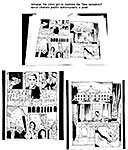
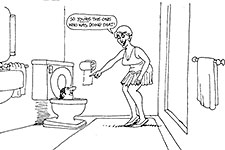
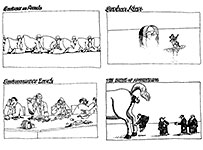

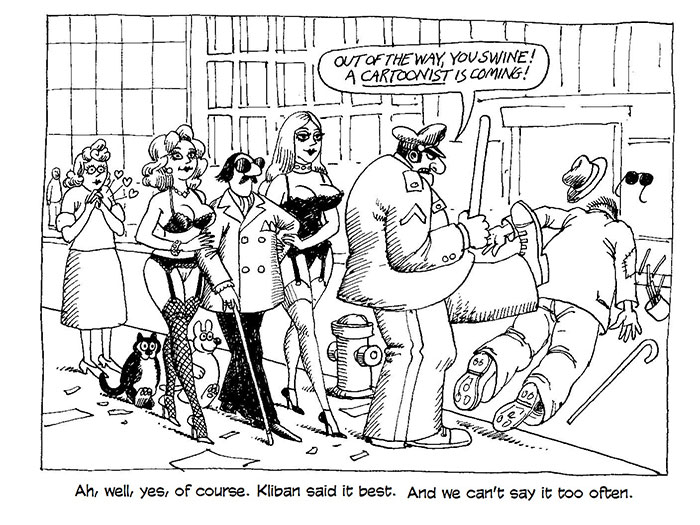
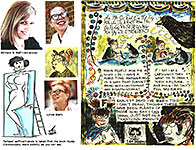
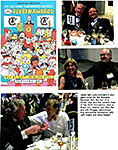

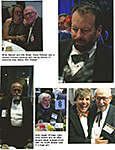
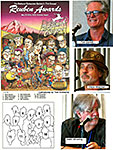
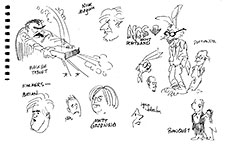
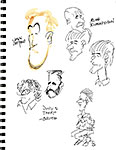
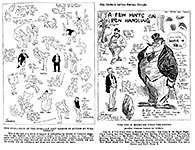
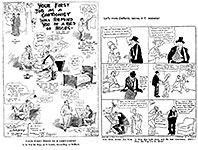
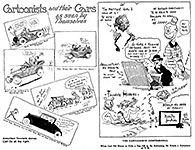
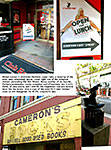
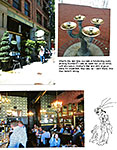
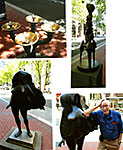
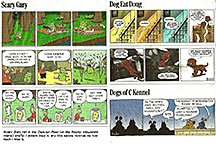
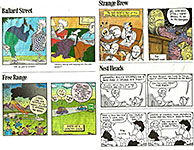
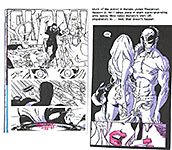
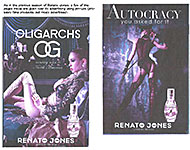
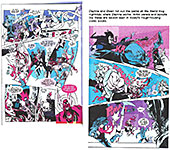
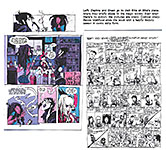
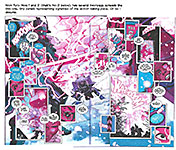
1.jpg)
2.jpg)
3.jpg)
4.jpg)
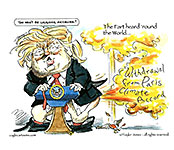
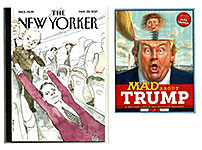
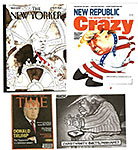
1.jpg)
2.jpg)
3.jpg)
4.jpg)
5.jpg)
6.jpg)
7.jpg)
8.jpg)
9.jpg)
